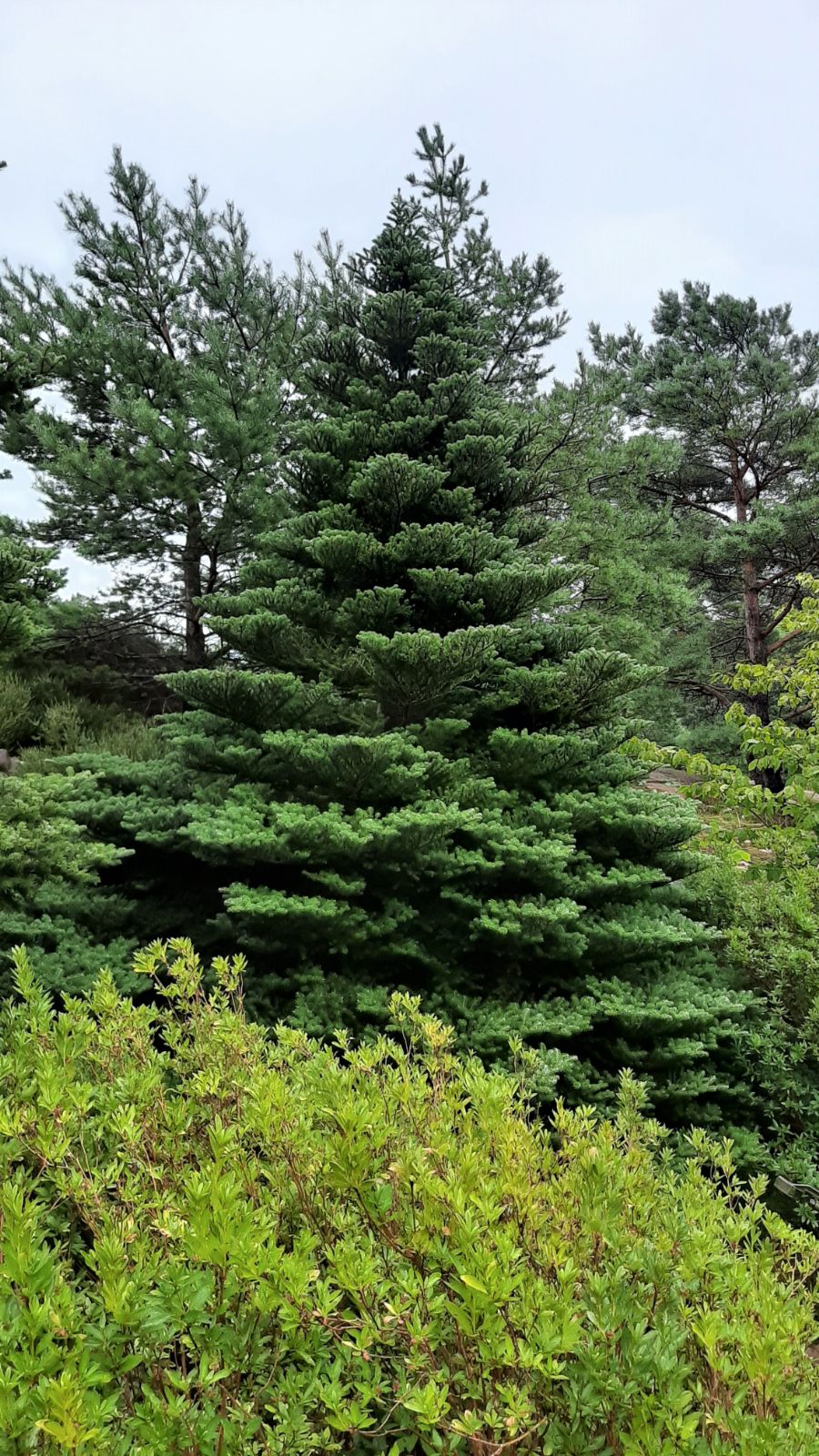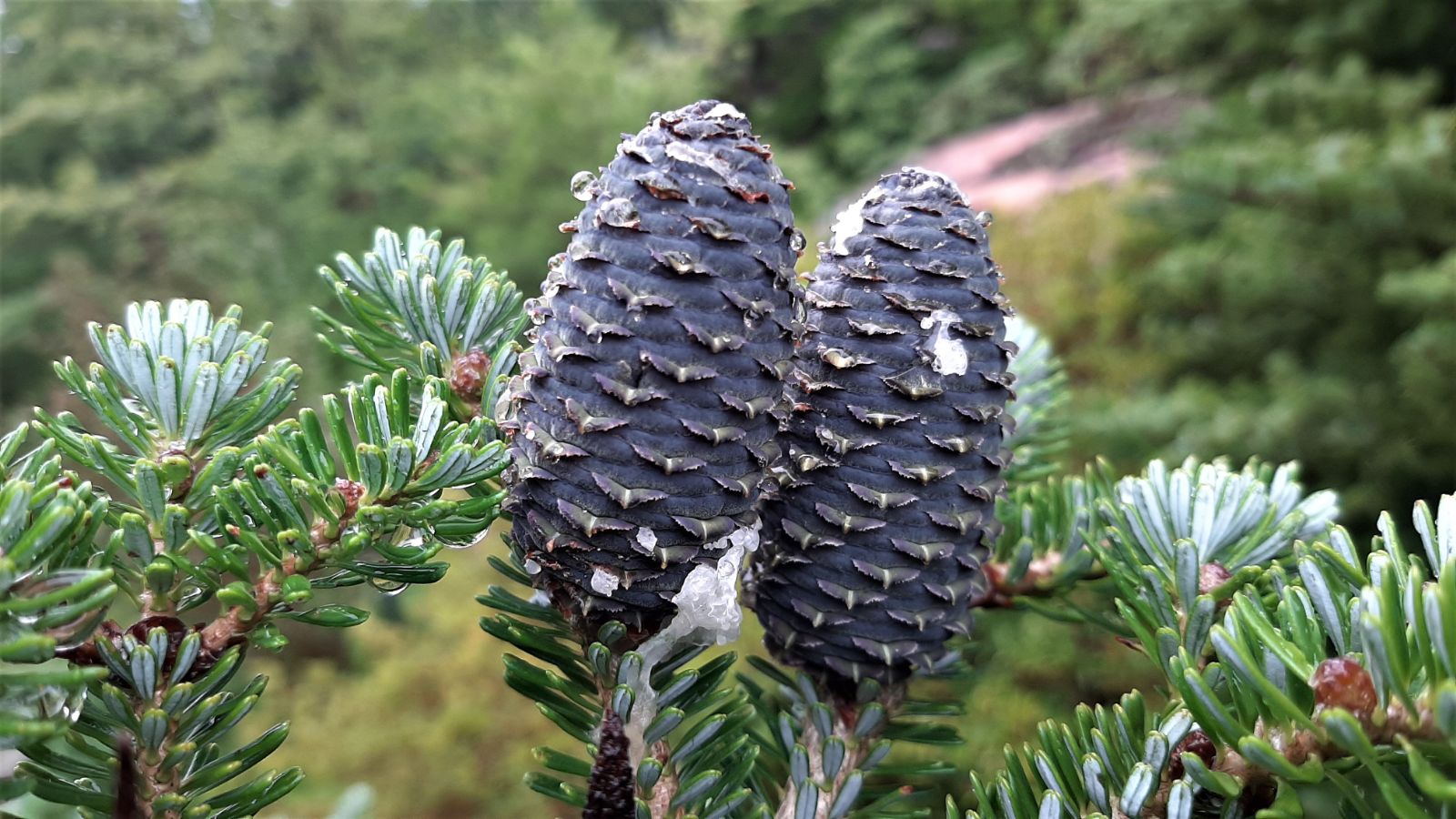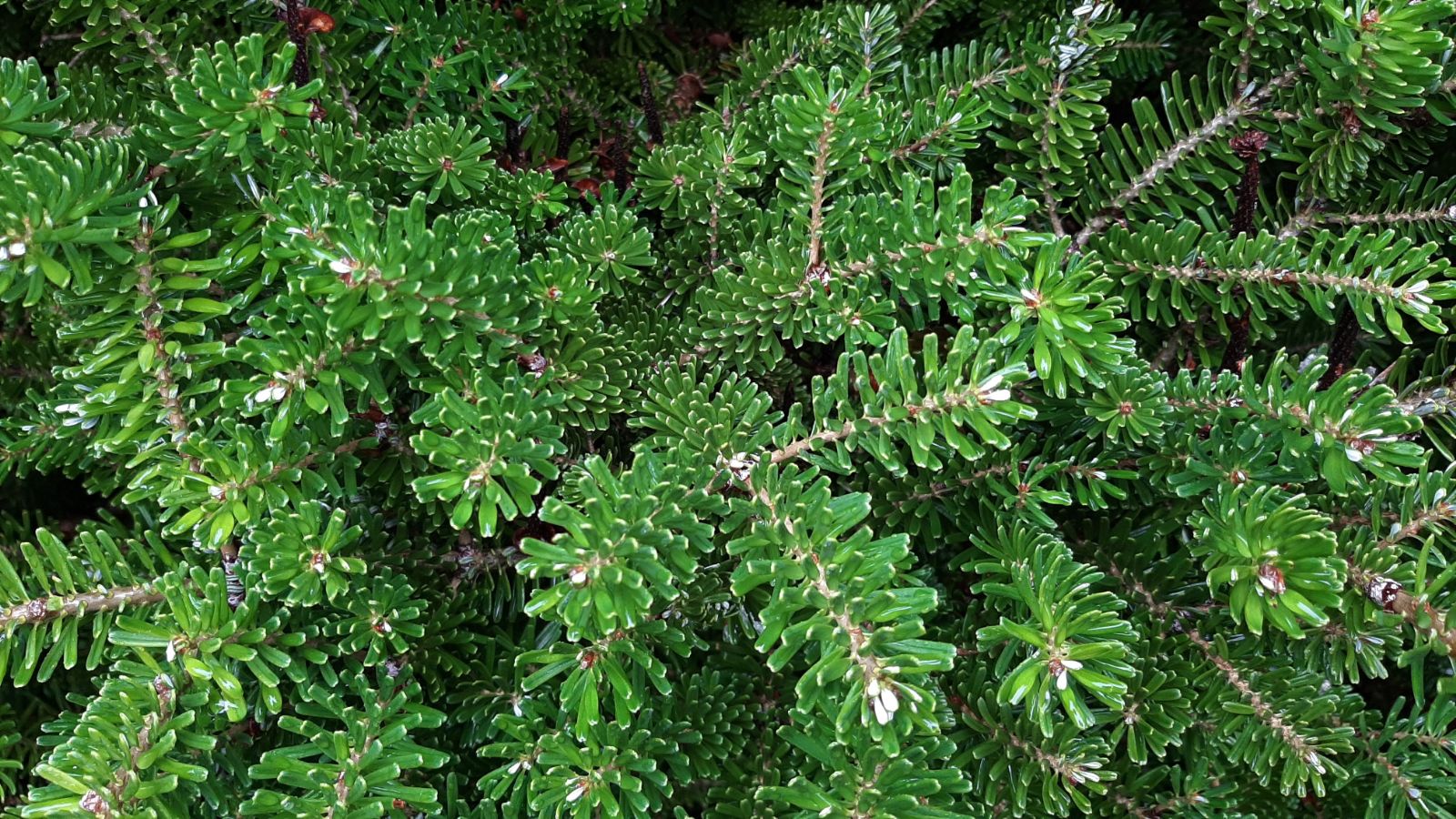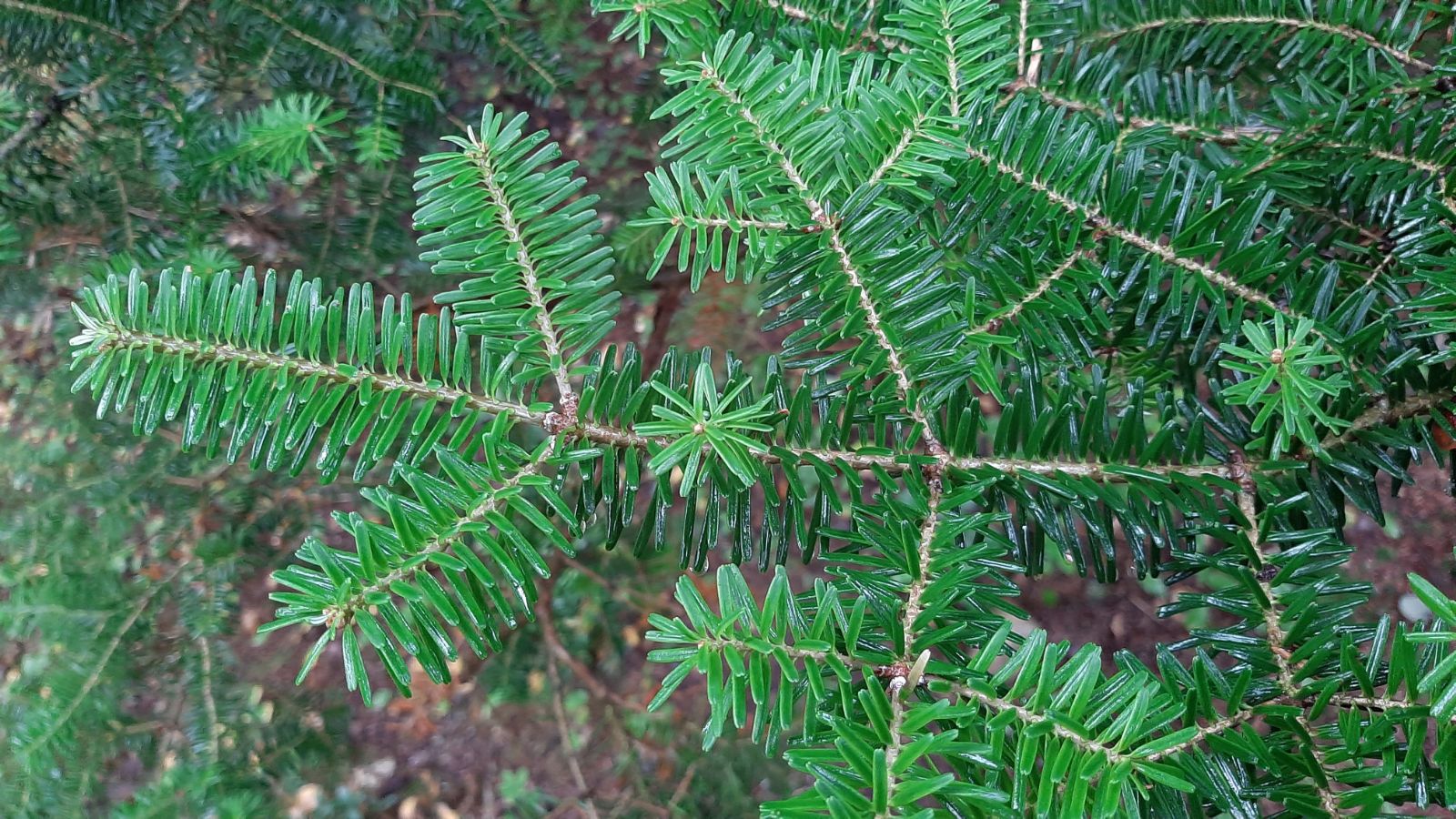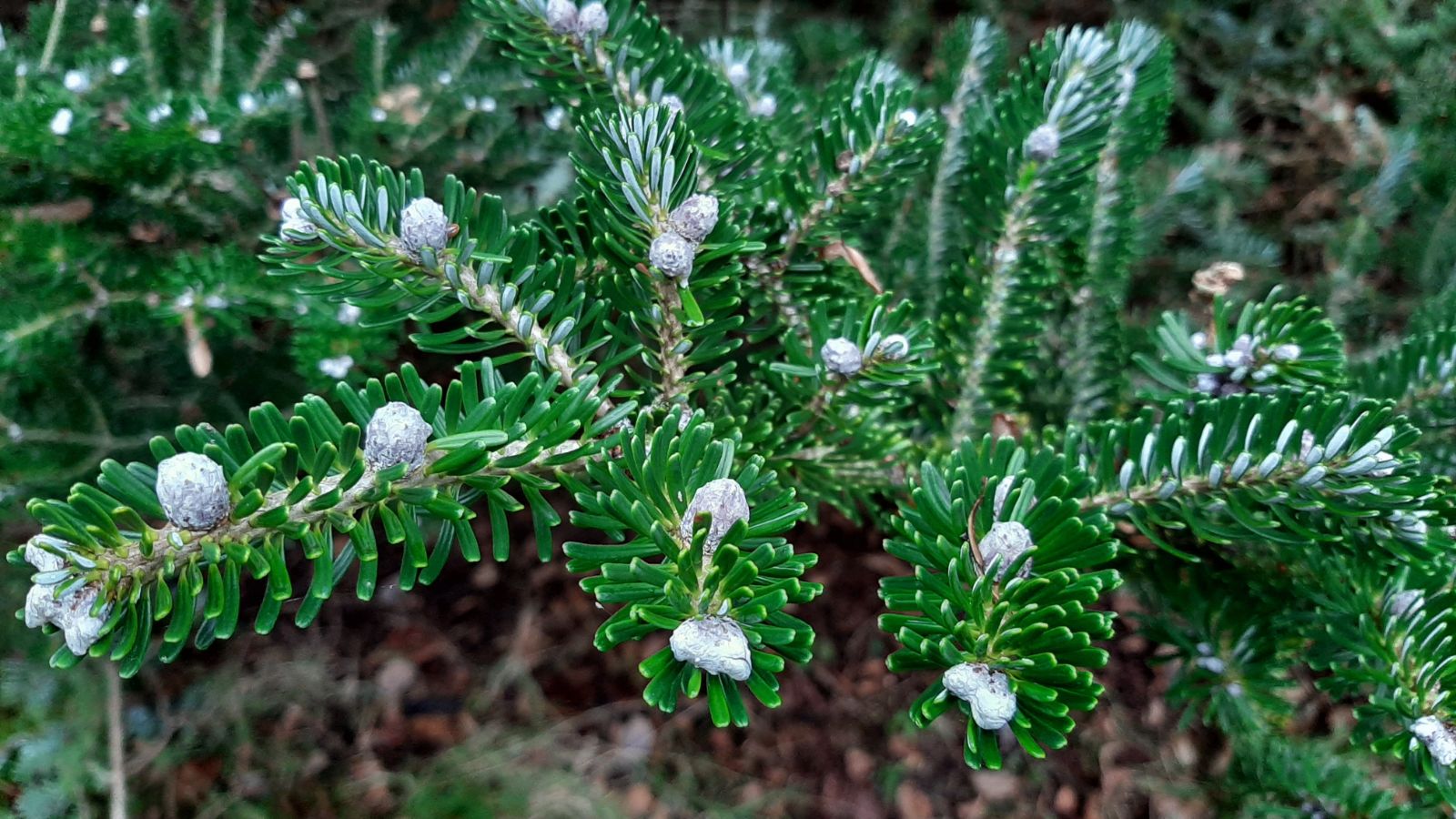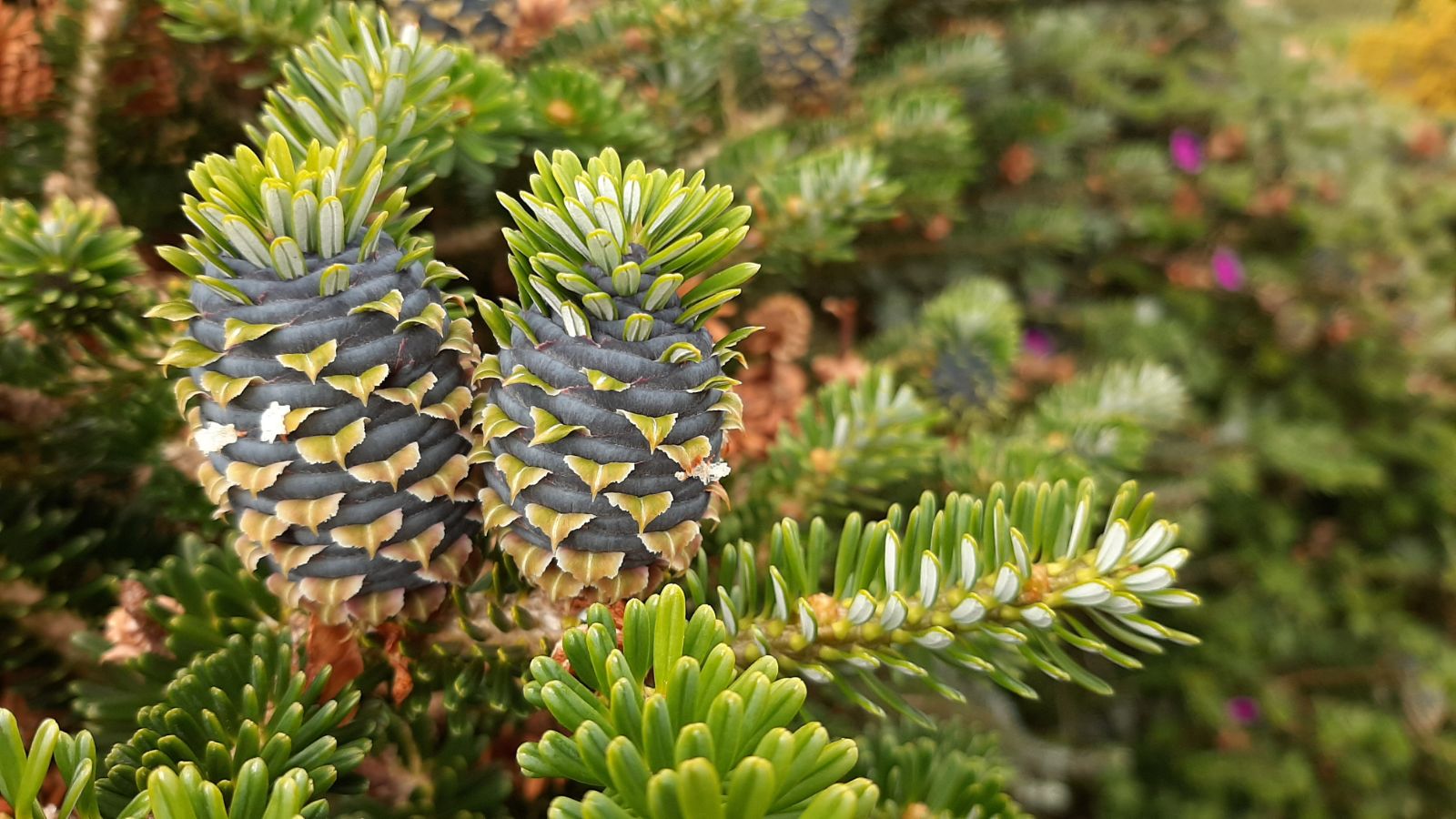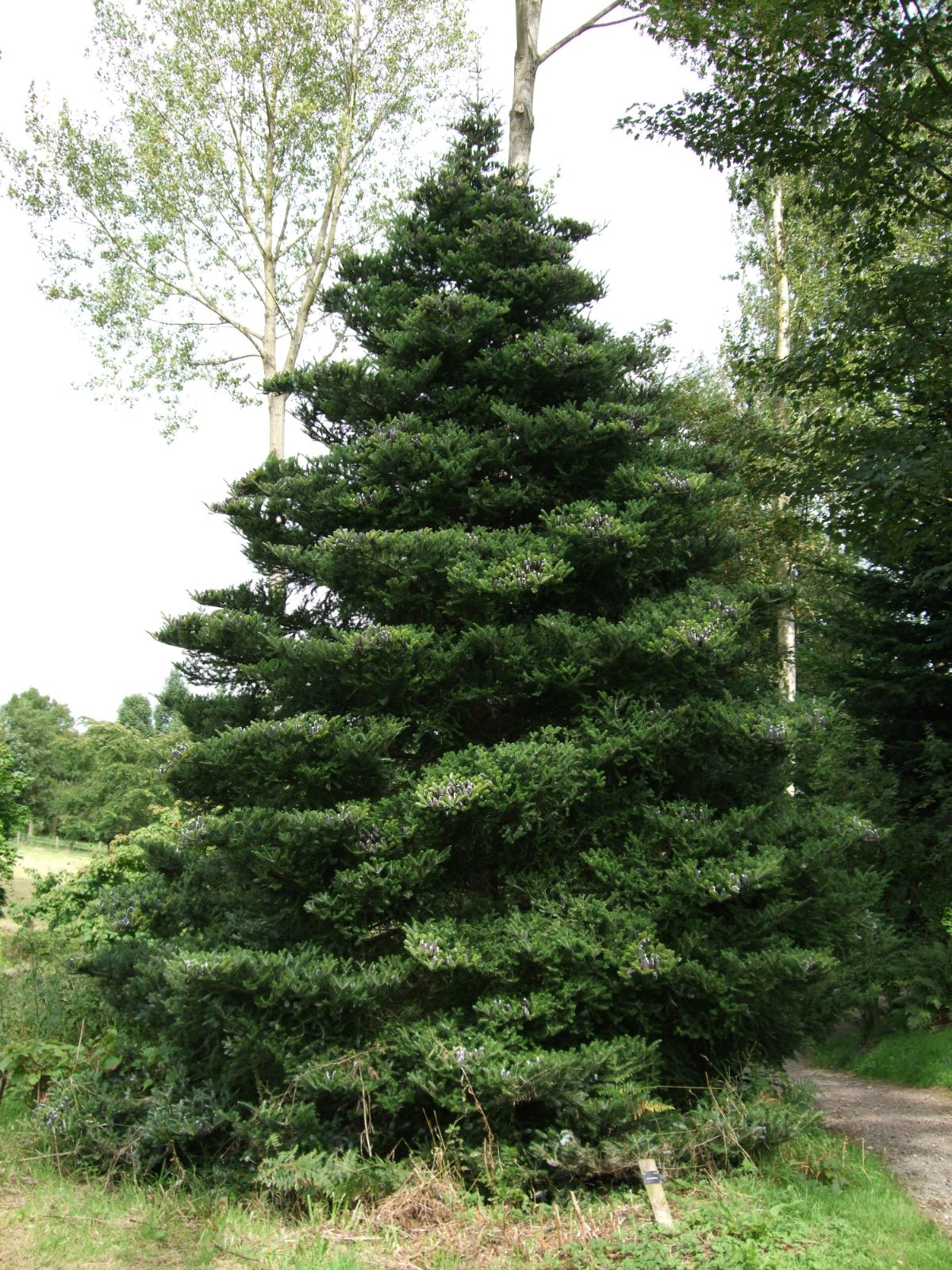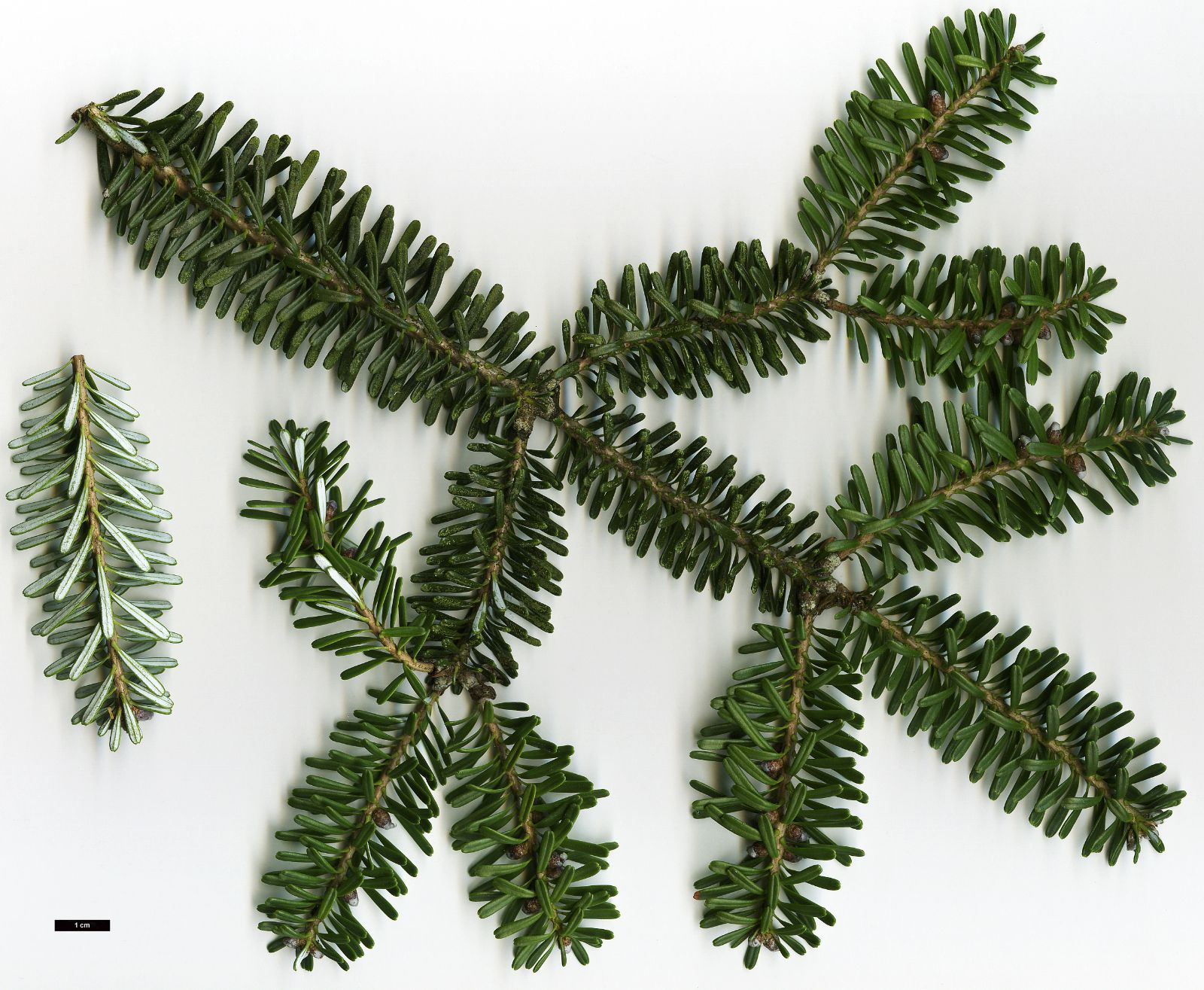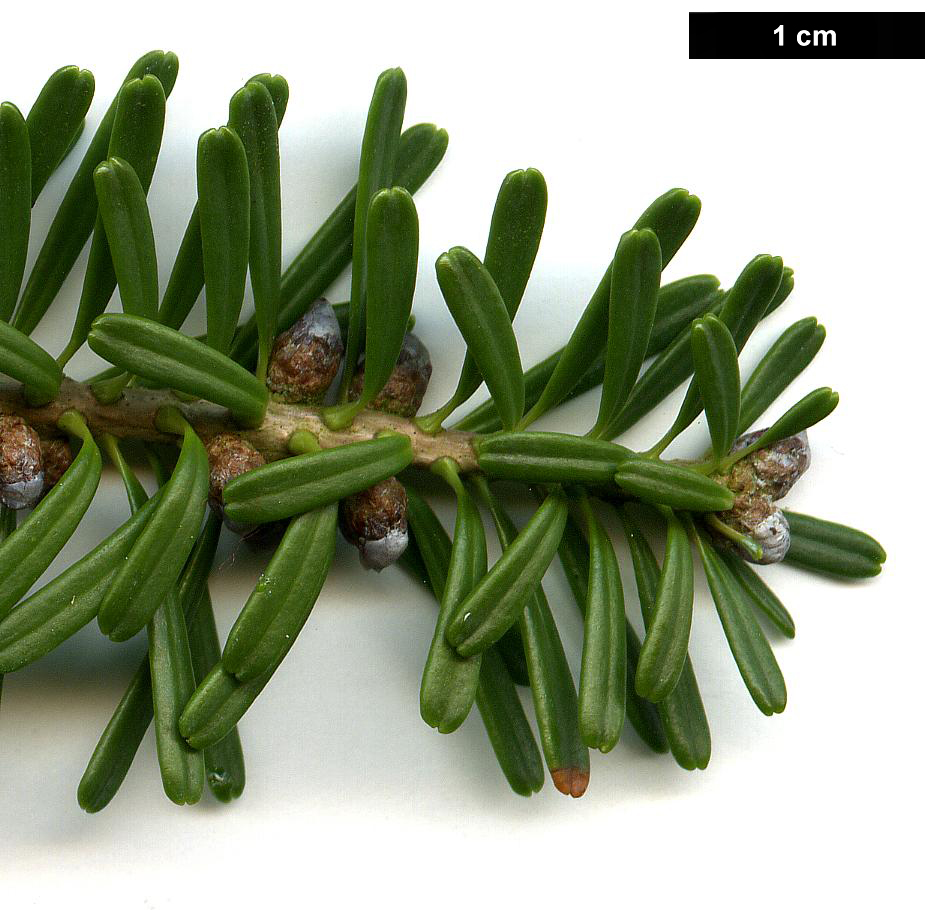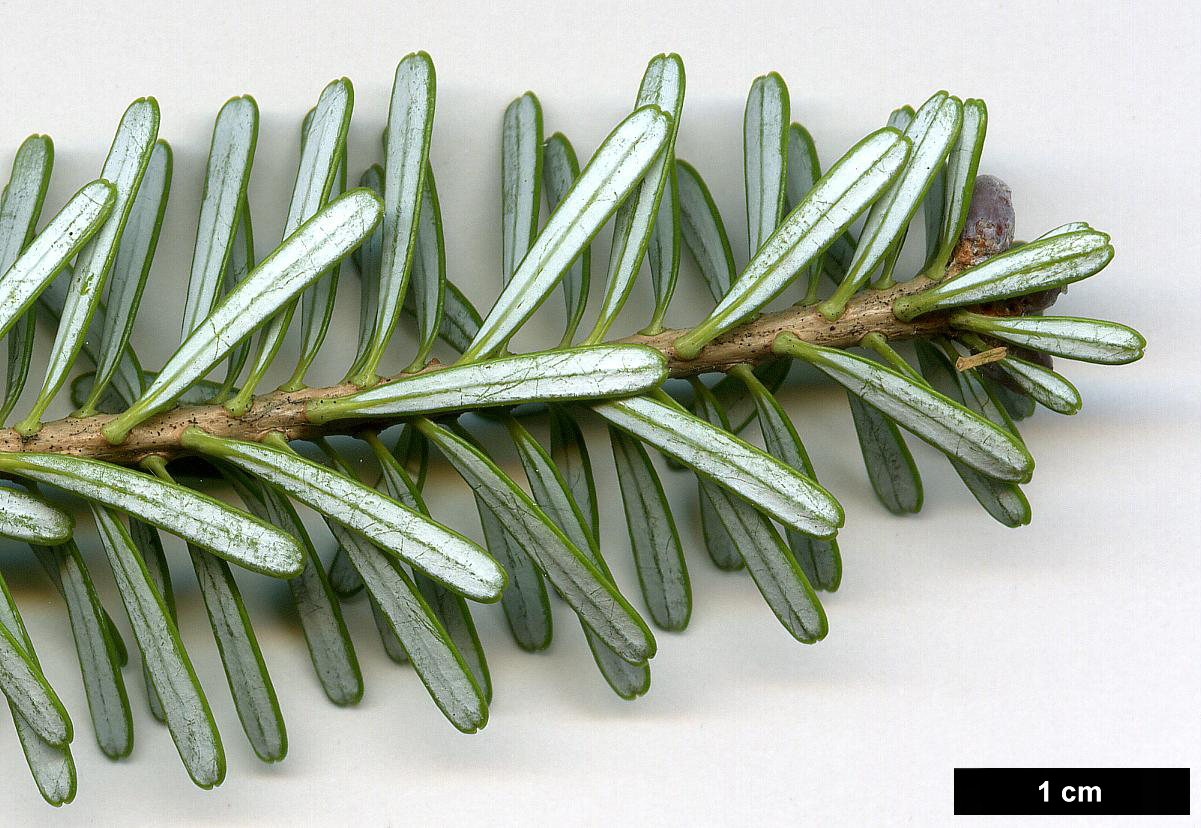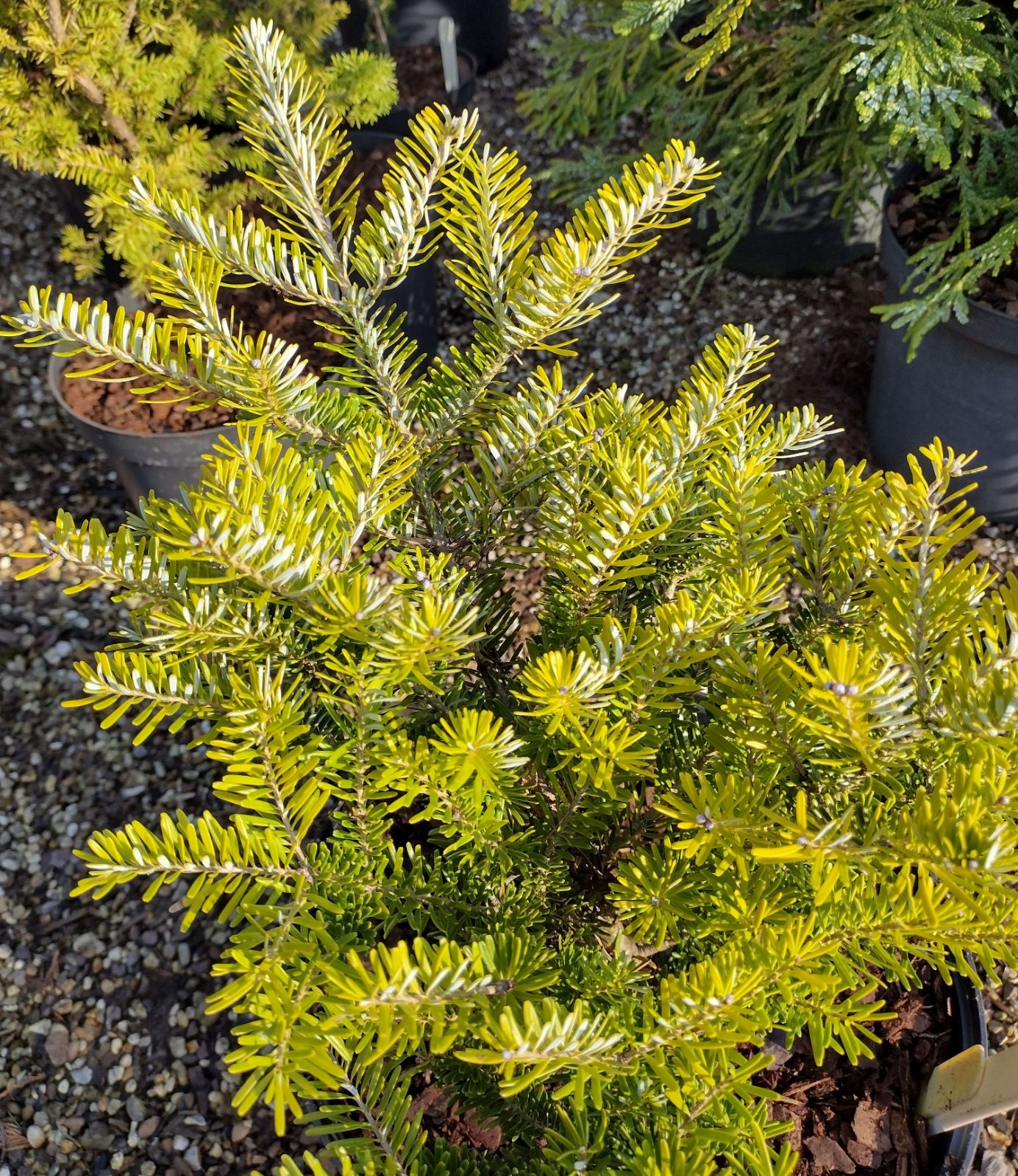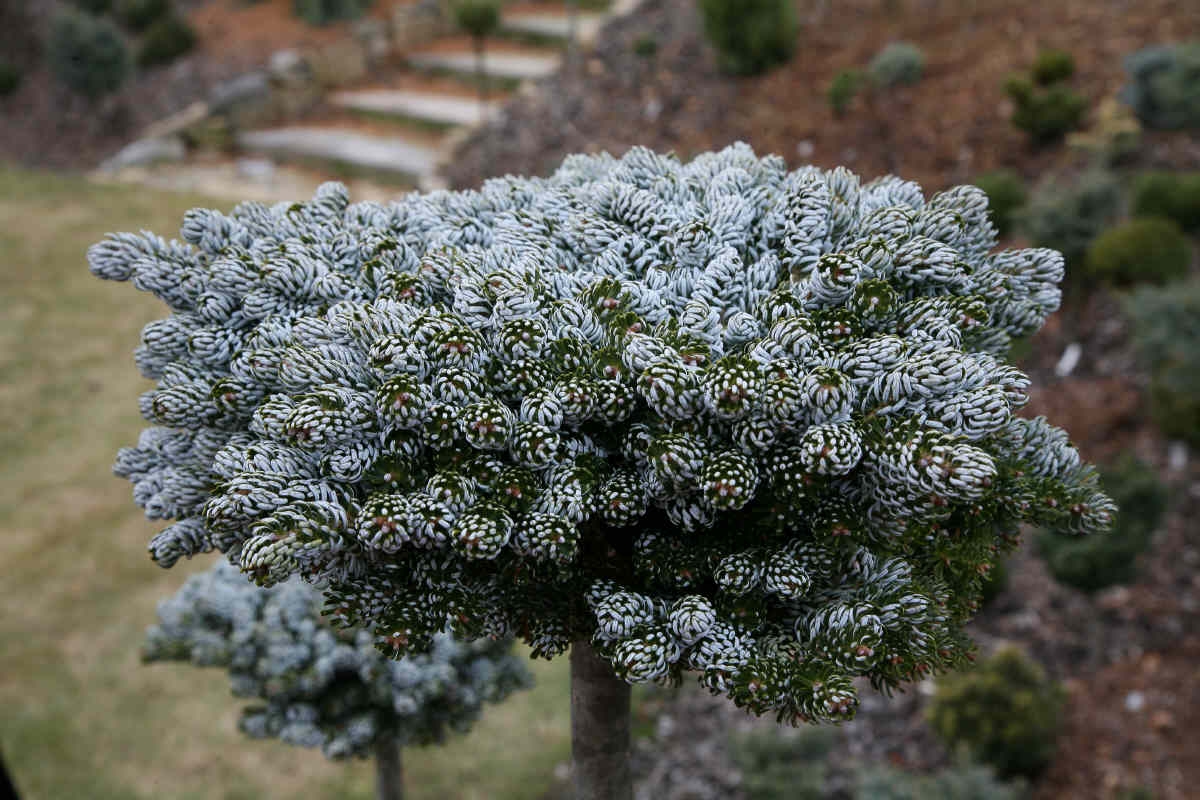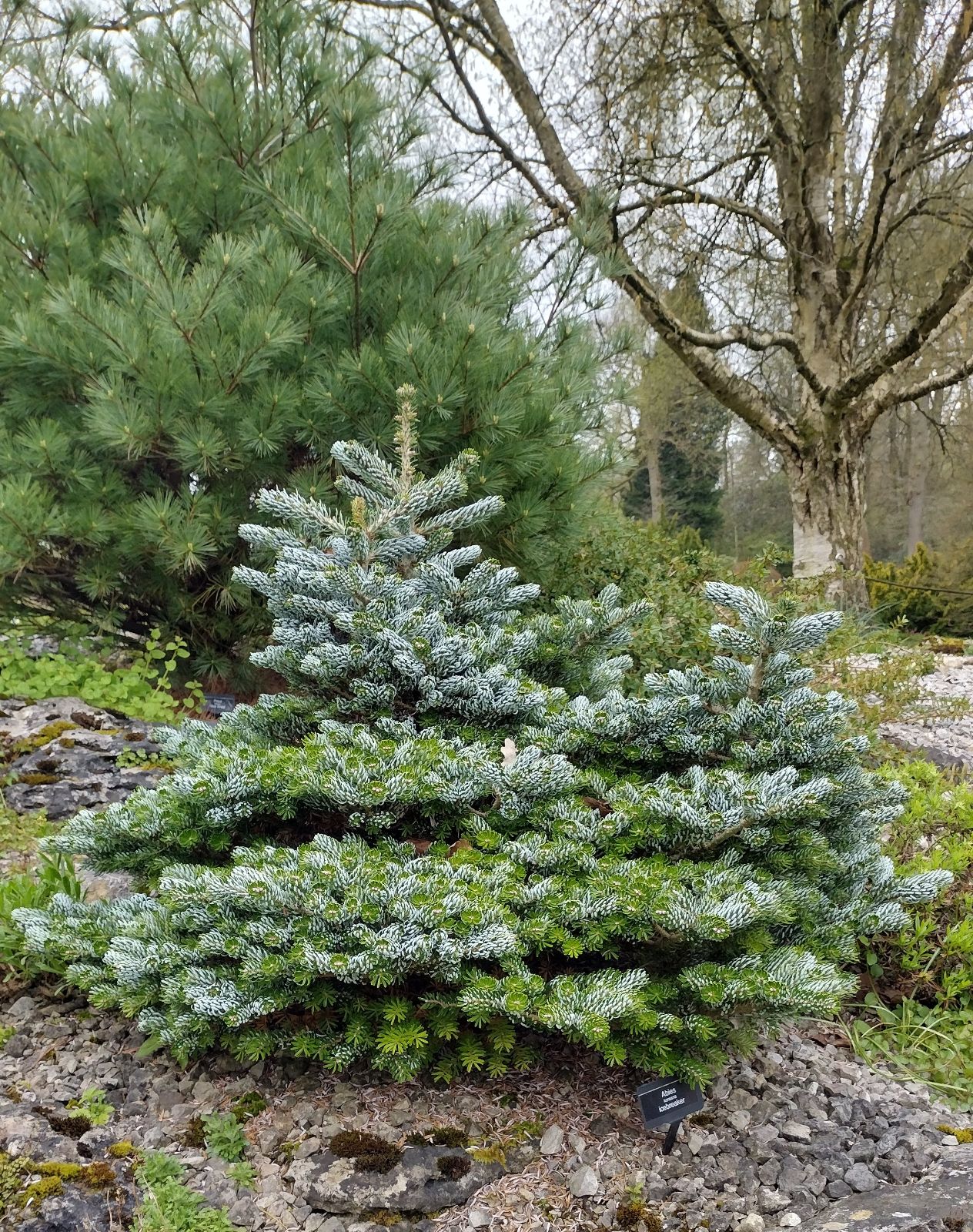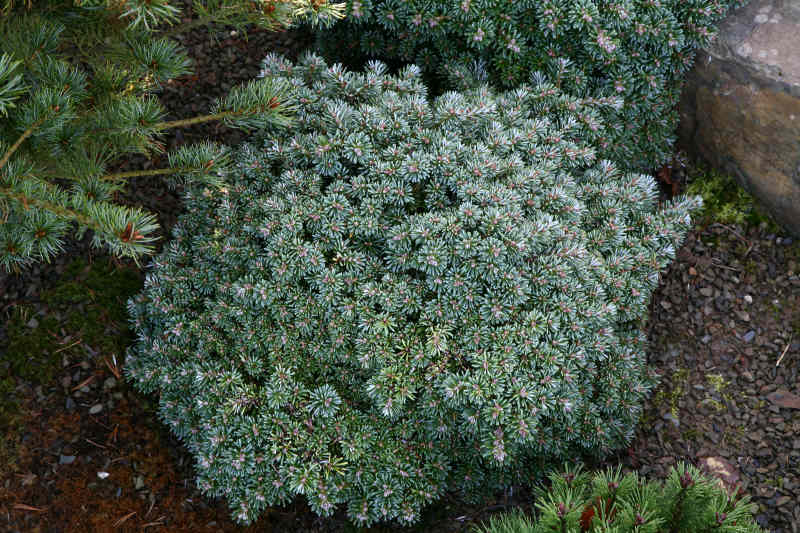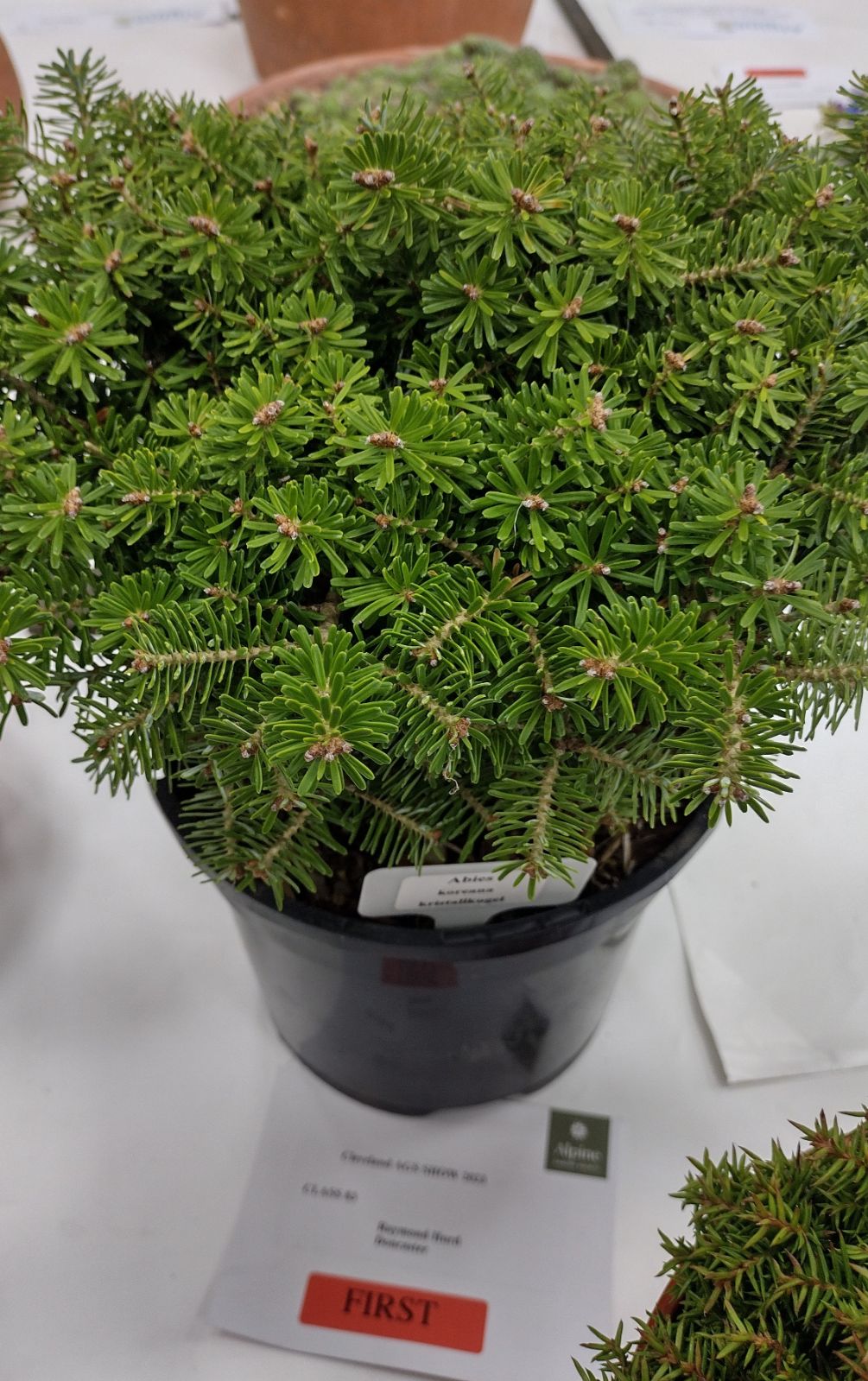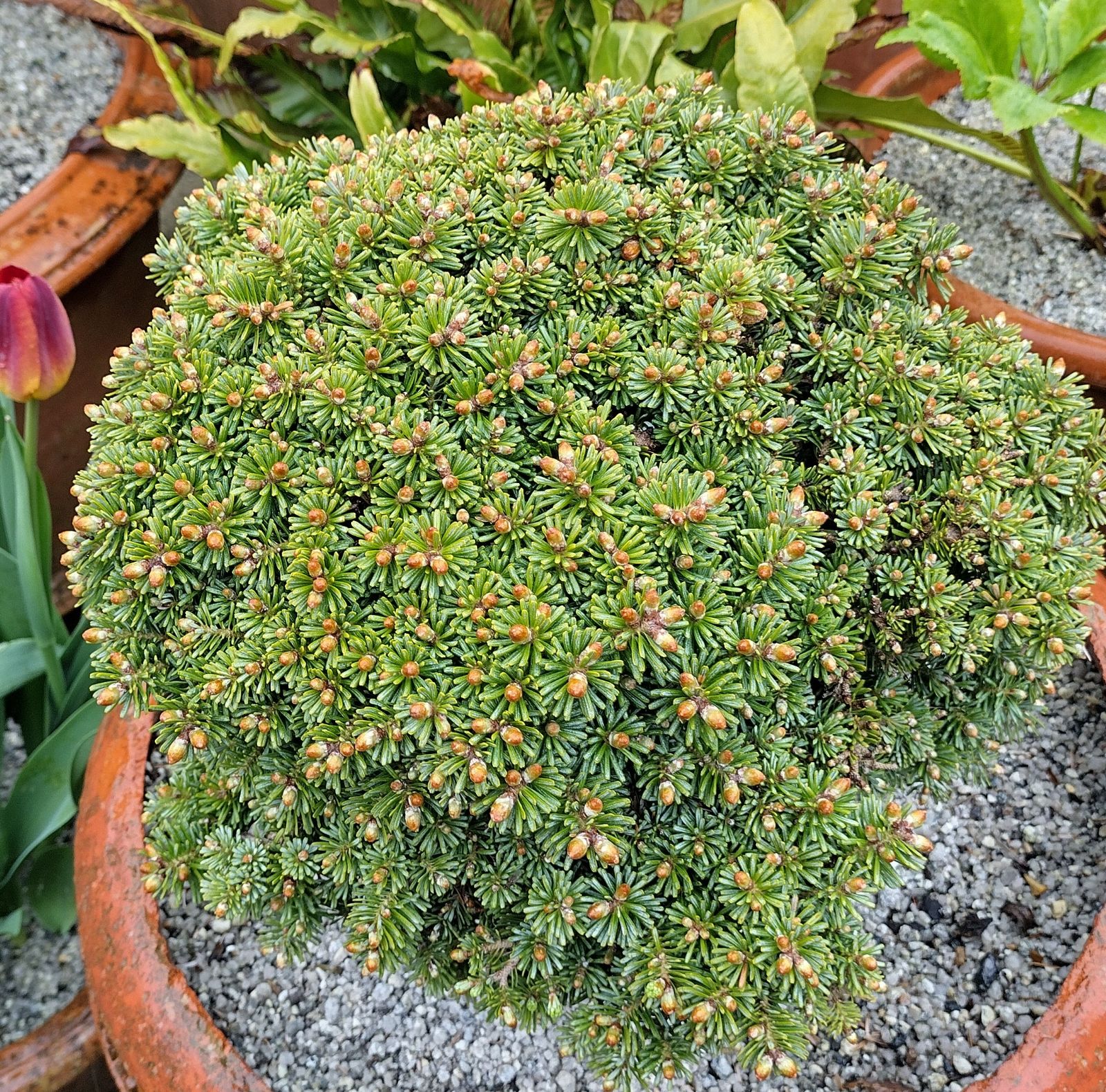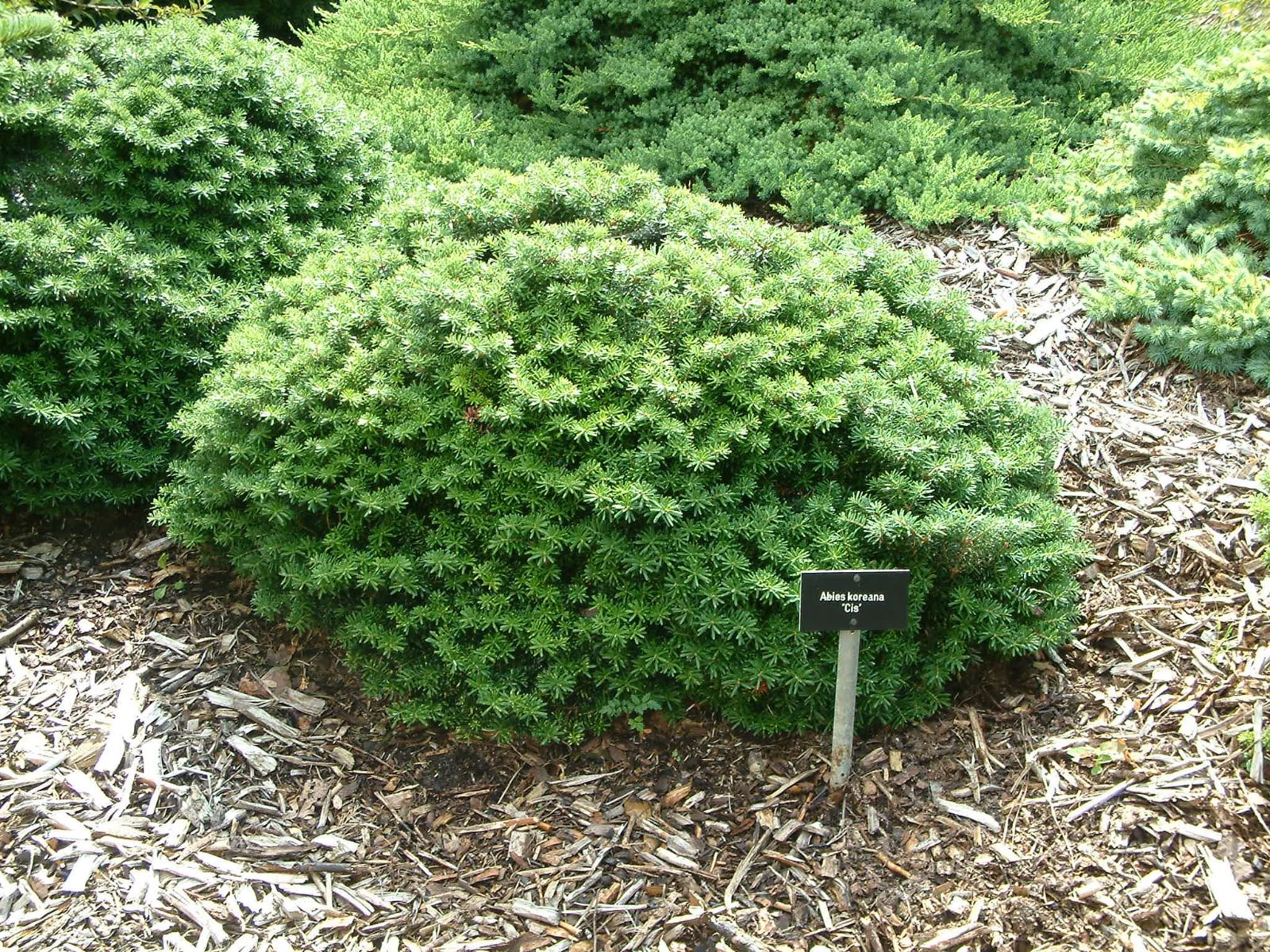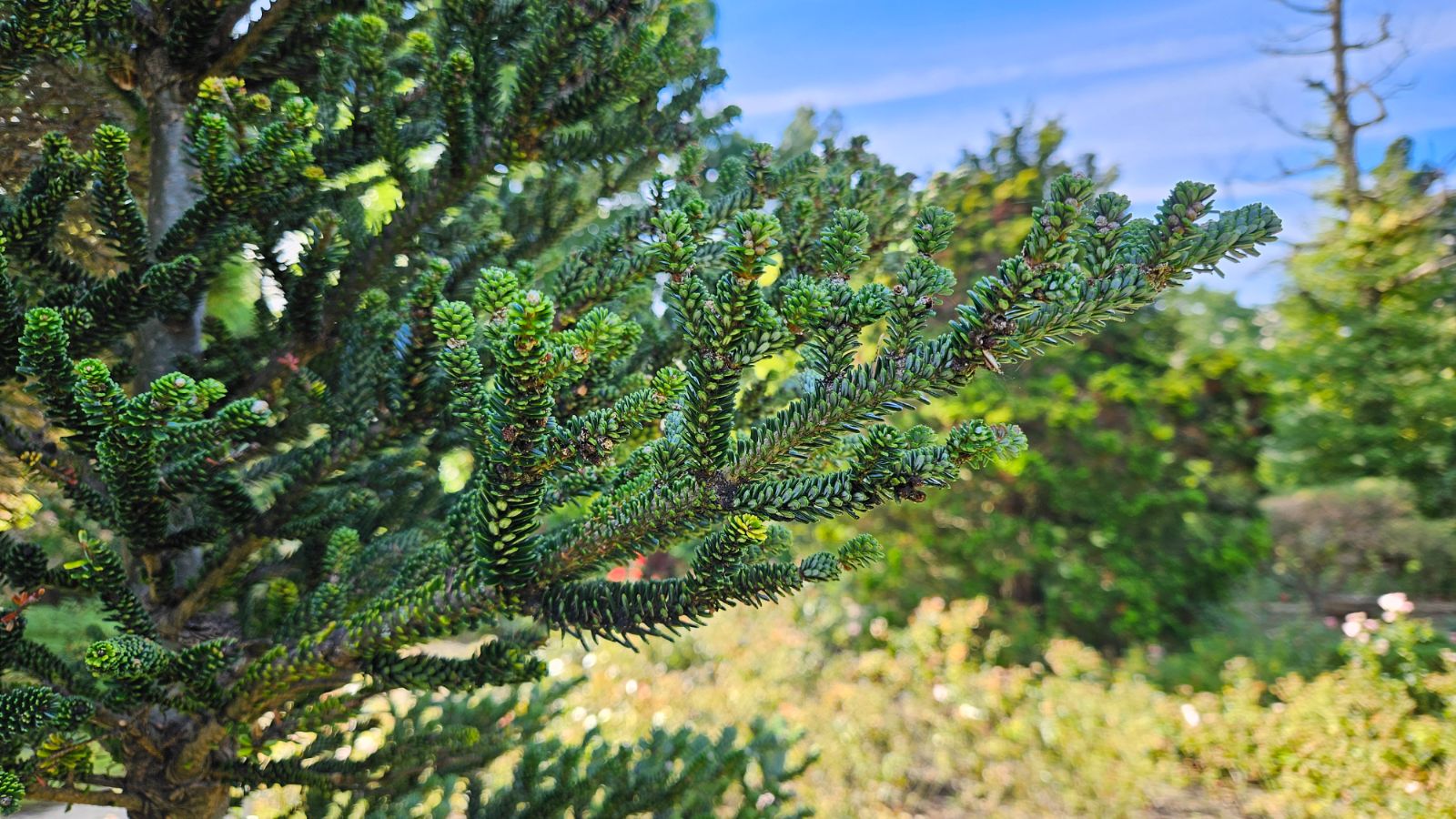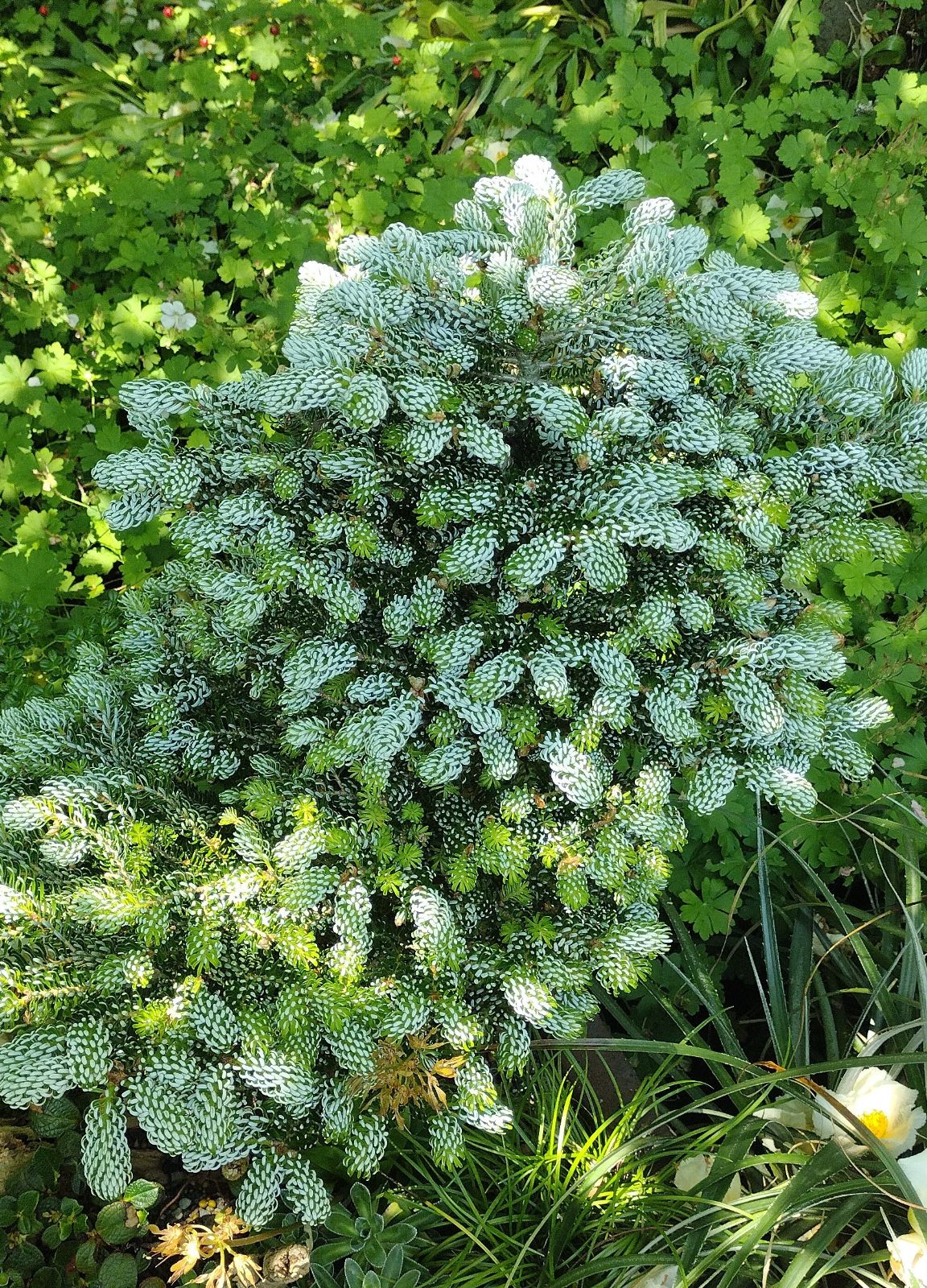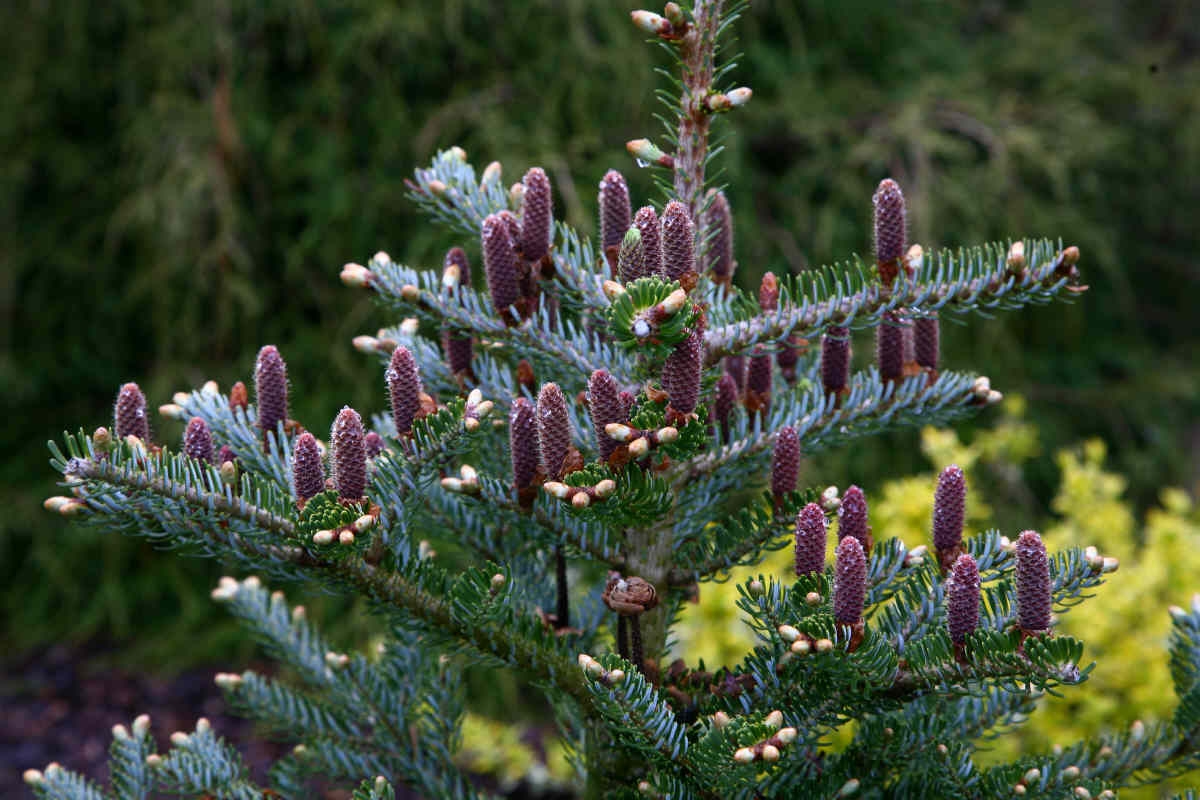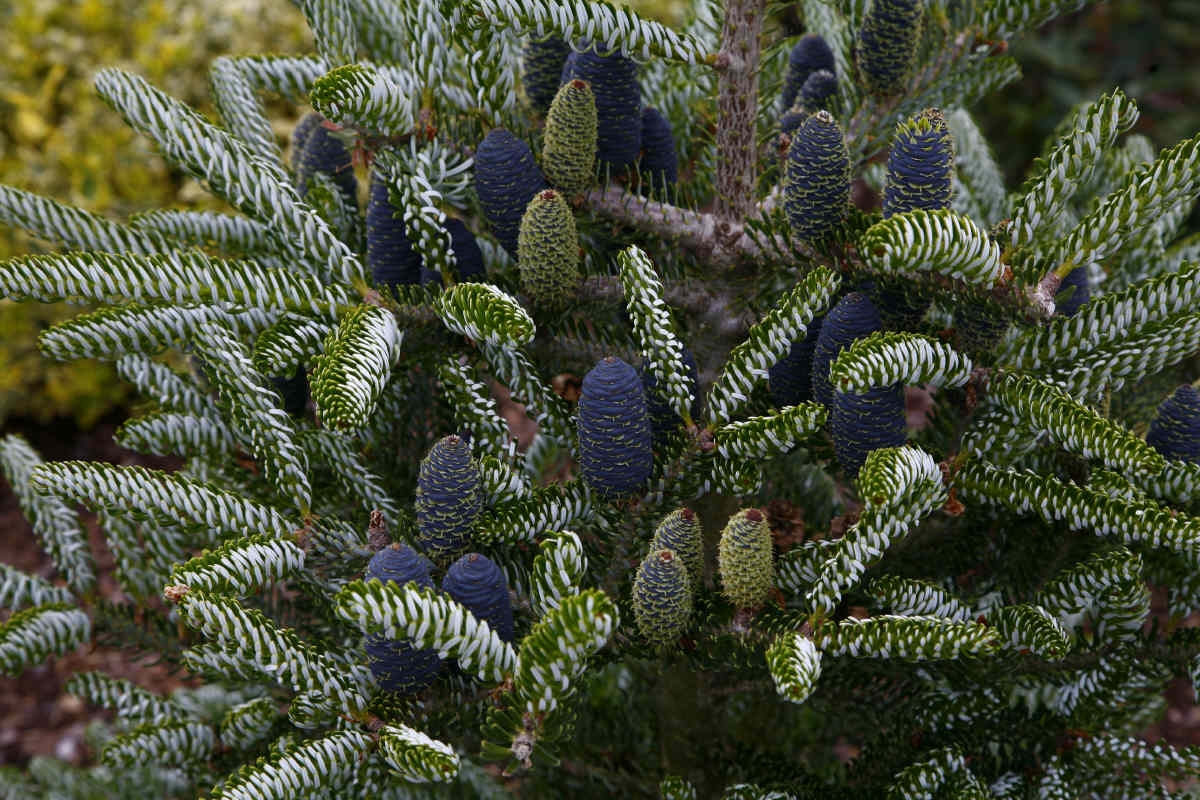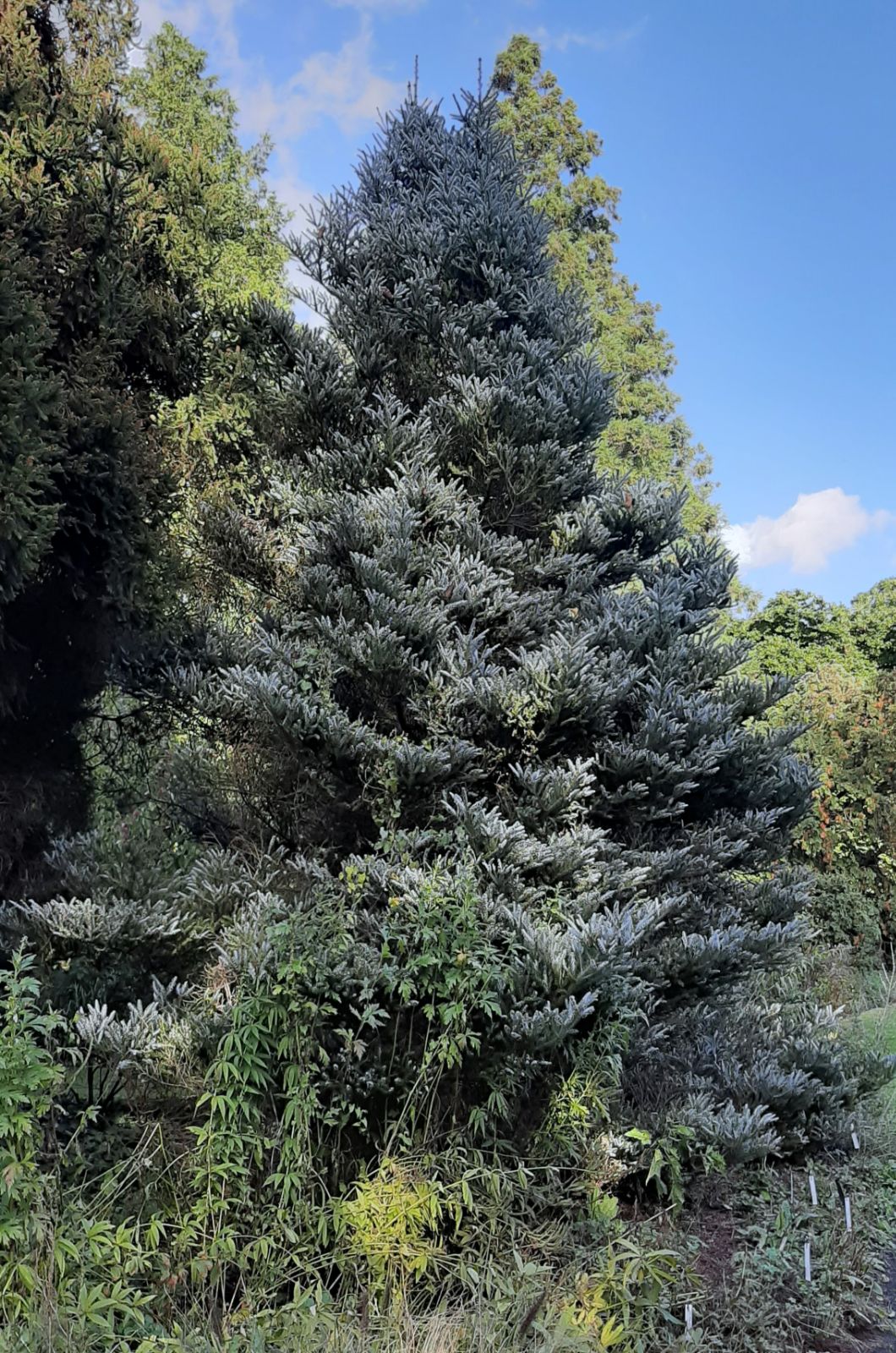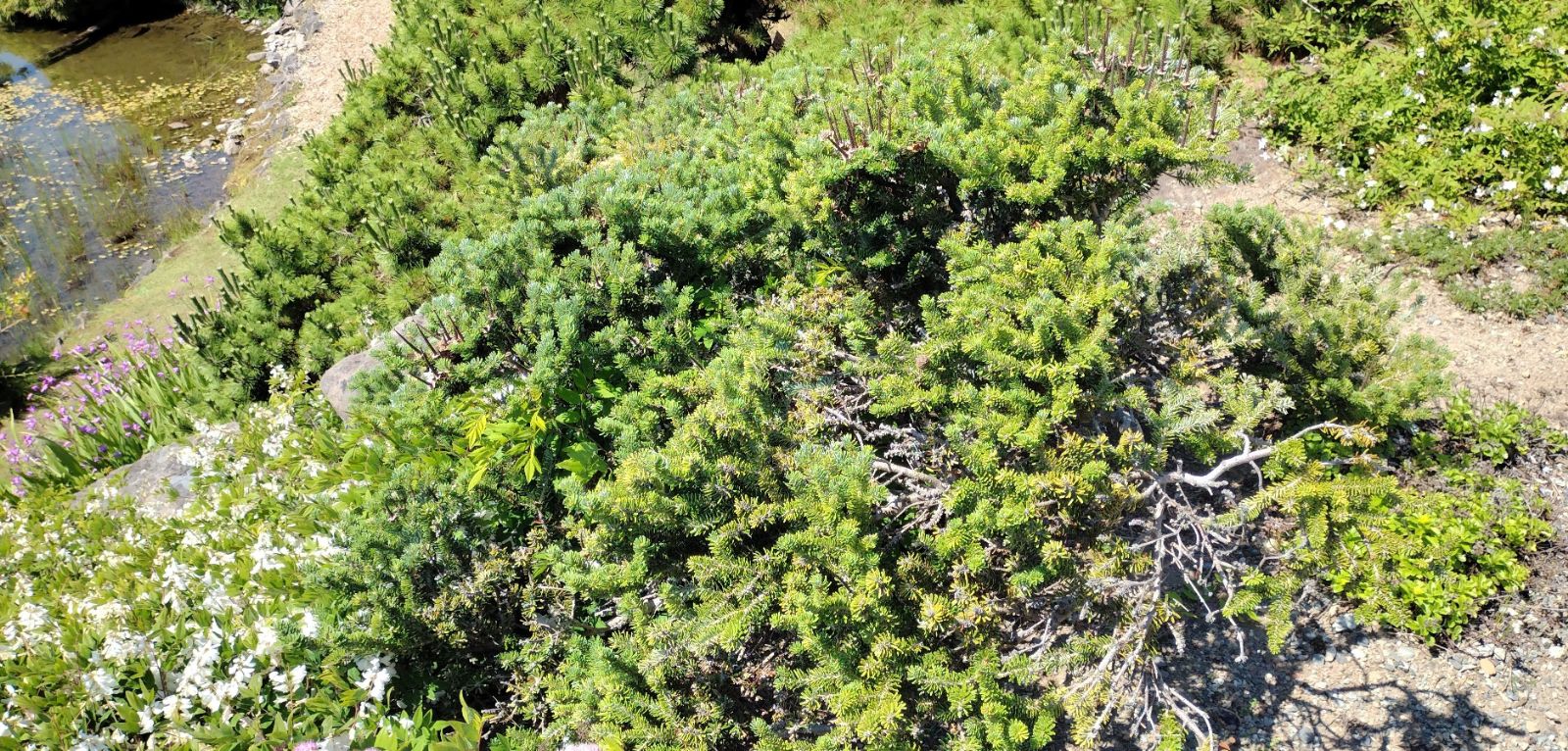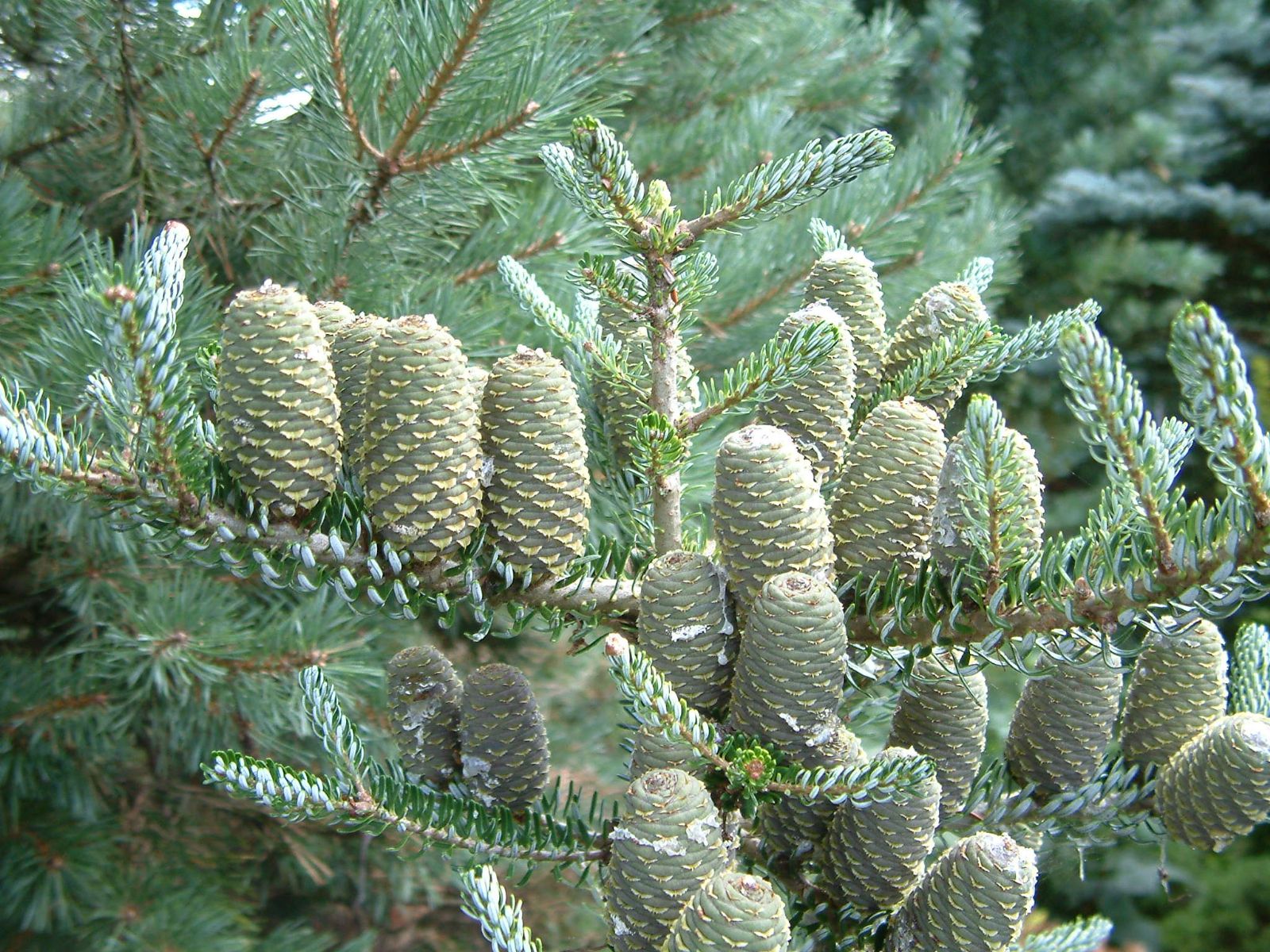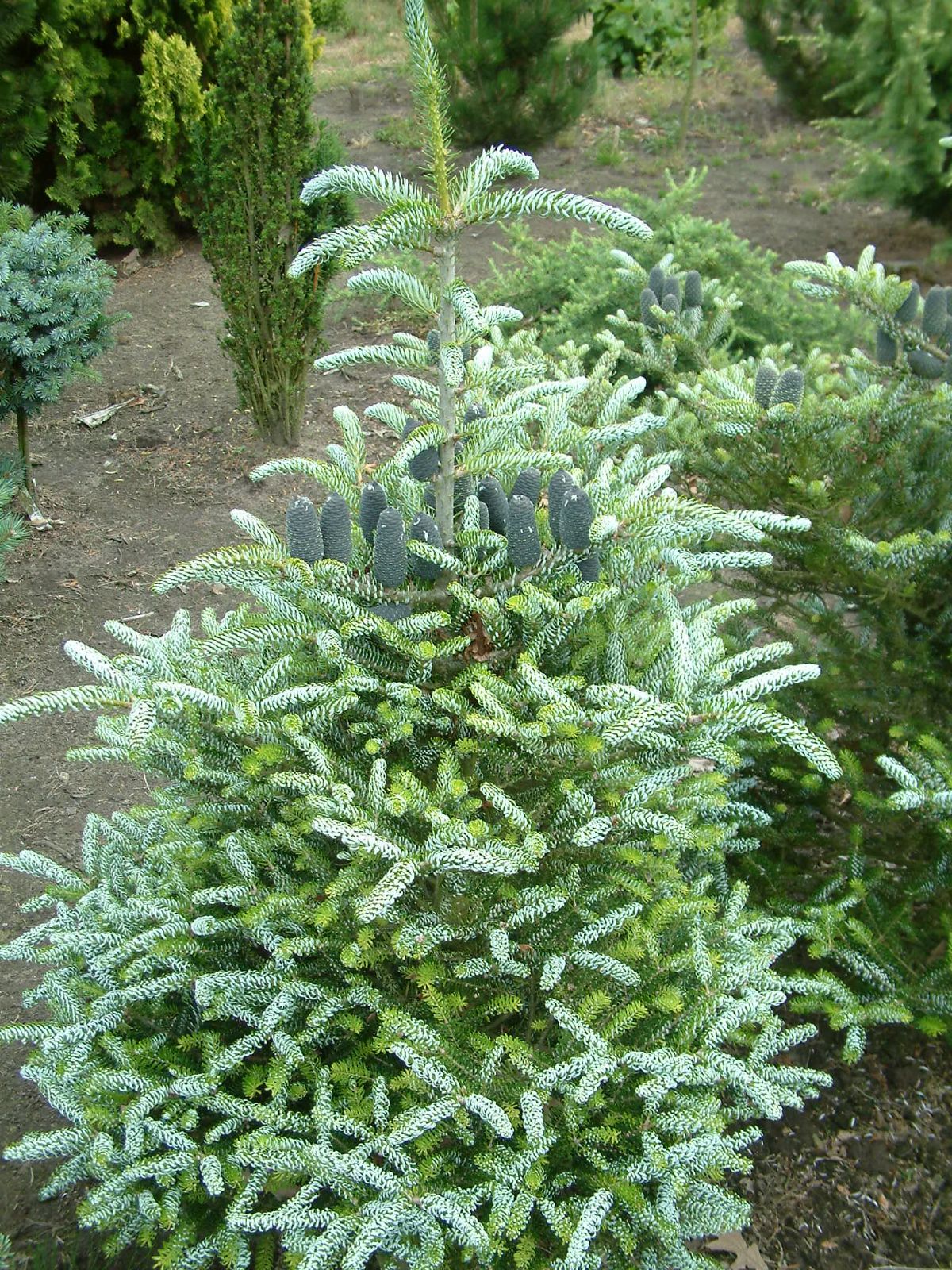Abies koreana
Sponsor
Kindly sponsored by
Sir Henry Angest
Credits
Tom Christian (2021)
Recommended citation
Christian, T. (2021), 'Abies koreana' from the website Trees and Shrubs Online (treesandshrubsonline.
Genus
Common Names
- Korean Fir
- Gu-sang-na-mu
Synonyms
- Abies koreana f. chlorocarpa T.B. Lee
- Abies koreana f. nigrocarpa Hatus.
- Abies koreana f. rubrocarpa T.B. Lee
Infraspecifics
- 'Aurea'
- 'Barabit's Compact'
- 'Blaue Einz'
- 'Blaue Zwo'
- 'Blue Emperor'
- 'Brevifolia'
- 'Compact Dwarf'
- Dwarf Cultivars
- 'Eisregen'
- 'Fastigiata'
- 'Flava'
- 'Freudenberg'
- 'Frosty'
- 'Gait'
- 'Gelbbunt'
- 'Golden Beskid'
- 'Goldener Traum'
- 'Horstmann's Silberlocke'
- 'Nanaimo'
- 'Prostrate Beauty'
- 'Silbermeltzer'
- 'Silberreif'
- 'Silver Show'
- 'True Blue'
- 'Vengels'
- 'Verdener Dom'
Other taxa in genus
- Abies alba
- Abies amabilis
- Abies × arnoldiana
- Abies balsamea
- Abies beshanzuensis
- Abies borisii-regis
- Abies bracteata
- Abies cephalonica
- Abies × chengii
- Abies chensiensis
- Abies cilicica
- Abies colimensis
- Abies concolor
- Abies delavayi
- Abies densa
- Abies durangensis
- Abies ernestii
- Abies fabri
- Abies fanjingshanensis
- Abies fansipanensis
- Abies fargesii
- Abies ferreana
- Abies firma
- Abies flinckii
- Abies fordei
- Abies forrestii
- Abies forrestii agg. × homolepis
- Abies fraseri
- Abies gamblei
- Abies georgei
- Abies gracilis
- Abies grandis
- Abies guatemalensis
- Abies hickelii
- Abies holophylla
- Abies homolepis
- Abies in Mexico and Mesoamerica
- Abies in the Sino-Himalaya
- Abies × insignis
- Abies kawakamii
- Abies koreana Hybrids
- Abies lasiocarpa
- Abies magnifica
- Abies mariesii
- Abies nebrodensis
- Abies nephrolepis
- Abies nordmanniana
- Abies nukiangensis
- Abies numidica
- Abies pindrow
- Abies pinsapo
- Abies procera
- Abies recurvata
- Abies religiosa
- Abies sachalinensis
- Abies salouenensis
- Abies sibirica
- Abies spectabilis
- Abies squamata
- Abies × umbellata
- Abies veitchii
- Abies vejarii
- Abies × vilmorinii
- Abies yuanbaoshanensis
- Abies ziyuanensis
Tree 15–20 m × 0.5–0.8 m dbh. Crown broad-pyramidal. Bark of young trees smooth, thin, with many prominent resin blisters, pale grey tinged purple or olive; maturing to dark grey, breaking into irregular plates. First order branches in obvious whorls often retained close to the base of the trunk, spreading more or less horizontally, the lowest branches slightly curved downwards; second order branches spreading horizontally or ascending in the upper parts. Branchlets slender, rigid, yellowish or greenish-grey, initially sparsely pubescent in shallow grooves, soon glabrous. Vegetative buds subglobose, 4–5 × 3–4 mm, very resinous. Leaves radially spreading around the shoots, (0.8–)1–2(–2.2) cm × 2–2.5 mm, linear or somewhat spathulate, curved or twisted at the base, apex obtuse or emarginate, somewhat back-swept especially on coning shoots, stomata in two broad bright whitish bands beneath, rarely slightly stomatiferous above. Pollen cones clustered, 1 cm long, yellow with reddish microsporophylls. Seed cones often densely set on the shoots, short-pedunculate, conical, apex obtuse, umbilicate, or papilliform, 4–7 × 2–3 cm, very variable in colour: greenish-red, reddish-purple, or violet blue with exserted reddish, violet, greenish, or yellowish bracts at first, maturing to dark purplish brown; seed scales reniform or wing-shaped, 1–1.2 × 1.2–1.6 cm at midcone; bracts varying from just exserted to prominently exserted and reflexed at maturity. (Farjon 2017; Debreczy & Rácz 2011; Kim et al. 2018).
Distribution North Korea Mt. Daeseong South Korea Mt. Chiri, Mt. Gaya, and Mt. Togyu on the mainland and Mt. Halla on Jeju Island.
Habitat In cool-temperate, sub-alpine forests at 1000–1900 m asl, typically in quite poor, shallow soils. Occasionally in pure stands but usually as a minor component of forests dominated by Picea jezoensis and Pinus koraiensis. Other associates include Quercus mongolica, Fraxinus mandshurica, Magnolia sieboldii, Sorbus commixta, and a diverse shrub layer including Juniperus, Deutzia and Rhododendron spp. On Jeju Island it occurs with Betula ermanii, Taxus cuspidata, Prunus spp., and Sasa quelpartensis.
USDA Hardiness Zone 4b-6
RHS Hardiness Rating H7
Conservation status Endangered (EN)
Taxonomic note Three formae names have been described to cover the enormous variation of seed cone colour: f. chlorocarpa, the Green-Cone Korean Fir; f. nigrocarpa, the Black-Cone Korean Fir; f. rubrocarpa, the Red-Cone Korean Fir (Chang & Kungnip 2015), however these names are not widely used and are of limited value, given that cones on a single tree can travel through a broad colour spectrum as they mature and, further, it is not clear that these traits are inherited uniformly by progeny.
Korean Fir has justifiably become one of the most widely planted firs in gardens. Its typically small stature, compact habit, and tendency to produce its ornamental seed cones from a young age, have all helped to secure it a place among the ranks of the most popular ornamental conifers. Old specimens can still occasionally be seen in a classic pinetum setting, but nowadays it is most commonly encountered in modest, domestic gardens, usually as one of the multitude of cultivars that now exist. In its natural state it is remarkably effective when planted in small groups as a backdrop to mixed plantings, as a specimen tree, or as an ‘edge’ tree, punctuating the transition zone from open areas into woodland.
The first westerner to see it was French Missionary Père Faurie, who found it on Jeju Island, Korea, in 1907 (Bean 1976). Faurie’s specimens, however, and those his compatriot Père Taquet gathered in 1909, would remain unnamed in the herbarium at Harvard University until 1920, when Wilson described the species following his visit to Korea in 1917. During this visit Wilson was able to confirm his suspicions, first aroused by the unnamed herbarium specimens, that the southern Korean populations were a new species (some authorities had considered them southern outposts of A. nephrolepis). We know from Bean (1976) that seed from Jeju Island was sent to the Vilmorin Nurseries in France in 1908, secured by Faurie or somebody acting on his behalf. Some of this seed was presumably sent across the Atlantic as Jacobson (1996) tells us the species was also cultivated in the United States from 1908. It arrived at Kew in 1913, perhaps as young trees from Vilmorin (Bean 1976). We cannot be sure which name accompanied any of these early consignments, for the name A. koreana was not yet published. Perhaps it was initially circulated as ‘Abies sp.’ or more likely ‘A. nephrolepis’.
Wilson later collected it in 1917, though whether additional gatherings had been made in the intervening years is unclear. It has been suggested that Wilson only collected Korean Fir on the mainland (e.g. Jacobson (1996)) but in his original description Wilson states that he secured a supply of seed from Jeju: ‘…in 1917 [I] visited [Jeju] island to study the living tree. I was able to secure a supply of seeds of this Fir which were sent to the Arnold Arboretum where plants are now growing’ (Wilson 1920). From his protologue it is clear that Wilson collected the species both on Jeju Island (between October 31 and November 5 1917, including his holotype W 9486) and again on the mainland (at Chiri-san, on November 16, W 9602), and although he doesn’t specify that he collected seed in both localities, it would be remarkable if he had not (Wilson 1920).
Rushforth (1987) observed that ‘the original introduction [from Jeju Island] produced many very small-growing trees which coned at an early age, often when less than a meter tall; recent introductions are from the mainland and may make better trees’. Whilst many did cone when young and small, this did not prevent some individuals growing into respectable trees. A tree of W 9486 (from Jeju) at the Arnold had achieved 18 m × 0.7 m dbh by 1988 (Warren & Johnson 1988). The same tree (presumably, for it is the only possible match reported from the Arnold’s database) had barely grown by 2016, when it was 19 m. It was finally removed in March 2019, but scions from it remain in the collection (Arnold Arboretum 2020). Several trees of uncertain origin in UK collections also exhibited moderate growth through the mid-20th century. An example at Hergest Croft, Herefordshire, was 9.75 × 0.29 m in c. 1970, aged 34 years. Another at Bedgebury National Pinetum, planted 1937, was 11.3 m in 1970 (Mitchell 1972).
As the 20th century passed A. koreana quickly gained popularity, but it is in the relatively recent past, in particularly the last 30–40 years, that it has been propelled to stardom. Its variability would become one of its greatest attributes as growers set to work on it; multiple selections have been named covering all manner of permutations, some of outstanding horticultural merit, and others of only dubious value. Auders & Spicer (2012) treat 91 named selections in their seminal work on conifer cultivars, and many additional names have appeared since that publication. Nearly all of these are rendered dwarf by the very nature of the species; like many original plants raised from Jeju Island seed, most named selections are incredibly slow-growing and of small stature. A significant portion may be termed ‘extreme dwarfs’, here taken to mean remaining well under 1 m tall after ten years, but often considerably smaller for considerably longer than this. In the interests of brevity these are not treated individually but are discussed together under the heading ‘Dwarf Cultivars’ below. Of those treated individually, most superficially resemble the species and are typical in growth rates and habit, unless otherwise stated. Some of the most remarkable cultivars have the foliage contorted so that the leaves are curved up above and around the shoots, permanently displaying their chalk-white undersides. ‘Horstmann’s Silberlocke’ is perhaps the most widely grown example of this type, though not necessarily the best.
Recent research into the genetics of 27 widely available A. koreana cultivars has provided interesting insights into their origins. They were found to correspond most closely to genotypes typical of the isolated population on Mt. Hallasan, Jeju Island. Since nearly all the cultivars sampled in the study were originally selected in cultivation in Europe and North America, this supports the supposition that material from Jeju was far more widely distributed (or at least more successful) in cultivation than mainland collections. The same study found evidence for hybrid origin in some selections, particularly in the cultivars ‘Inge’ and ‘Oberon’ which show introgression of A. balsamea genes, which can only have occurred in cultivation. Additionally, only two wild samples (and two cultivated samples from Korea) showed any affiliation with the closely related species A. nephrolepis and A. veitchii (Kwak et al. 2020).
This is surprising, especially in the latter case, given that it is well known in horticulture that Korean Fir hybridises freely with A. veitchii wherever the two are grown together (Rushforth 1987). The nothospecies A. × arnoldiana was described from material growing in Gothenburg Botanic Garden, Sweden, raised from seed sent from the Arnold Arboretum that had been gathered from a Wilson plant of A. koreana, but no mention of this nothospecies is made by Kwak et al. (2020). A plant growing at the Sir Harold Hillier Gardens, UK, is labelled ‘Abies Bedgebury Hybrid’; this clearly shows the influence of A. koreana but its other parent is, as yet, indeterminable (pers. obs. 2020).
Evidence for the influence of A. nephrolepis has been found before in wild populations of A. koreana (Chang, Jeon & Hyun 1997) and material growing at Dawyck Botanic Garden, Scotland, gathered on Chiri-San in 1989 by Kirkham, Flanagan and Boyce (KFB 99, as A. koreana) has been determined to represent a hybrid with A. nephrolepis (pers. obs. 2016). Further plants of this collection in other institutions vary; some appear to be ‘good’ koreana, others are more like the trio at Dawyck. Nevertheless, the potential for hybrid forms to occur in wild-collected seed batches could significantly undermine the perceived conservation value of material held in ex-situ collections (see also A. nebrodensis). Given Korean Fir is classified as Endangered (Kim et al. 2018) it is imperative that any future conservation collections of the species are informed by conservation genetics.
'Aurea'
A low-growing selection generally remaining broader than tall for many years, but inclined to develop a leader eventually. The leaves are golden yellow at first, becoming a duller, yellow-green as they age. Introduced by Lohbrunner Nursery, British Columbia, in 1956 (Auders & Spicer 2012).
'Barabit's Compact'
Like a miniature version of the typical species, forming a compact pyramid of dense growth, to 1.8 × 1 m in ten years. This cultivar name has also been used under A. nordmanniana; only one use of a cultivar name is permitted in a single genus, so one of these names must be changed (Auders & Spicer 2012).
'Blaue Einz'
A broad-concial plant of slow growth with strongly glaucescent leaves, to 1.5 × 1.2 m in ten years (Auders & Spicer 2012).
'Blaue Zwo'
Similar to ‘Blaue Einz’ but an older selection, raised in Germany c. 1970, with less rich blue colouration (Auders & Spicer 2012).
'Blue Emperor'
Auders & Spicer (2012) called this ‘the best of the tall, blue-needled Korean fir cultivars’. Its origin is uncertain but it has been available in Europe since at least 2000. Up to 3 m tall in ten years.
'Brevifolia'
Introduced by the Jeddeloh nursery c. 1965, this selection has very short, stiff leaves to a maximum of 1 cm long. The cones are also very small compared to the species typical (Auders & Spicer 2012).
'Compact Dwarf'
A slow-growing selection forming a compact pyramid at first, later wide-spreading with age. Most bizarrely for a species so-often marketed for its cones, it is noted for being nearly sterile! Found in the Pinetum Blijdenstein, the Netherlands, sometime before 1965 (Auders & Spicer 2012). At Longwood in the US there is an old plant, several meters across (Hatch 2021–2022).
Dwarf Cultivars
Many of the A. koreana cultivars discussed individually could reasonably be described as dwarf. Indeed, many plants raised from wild-sourced seed would also qualify as such. In order to keep the listing of cultivars from becoming unwieldy, the very smallest, likely only of interest to specialist collectors, are grouped together here in a simple (non-exhaustive) list of names. All of the cultivars given below are either extreme dwarfs, or very slow, or both, here taken to mean that they remain below 1 m tall after ten or more years of growth. Characteristics associated with each selection are given after the name, but in reality many of these names represent a second (or greater) find of precisely the same mutation as was used to justify an earlier name. For example, besides their distinct origins, there is really no significant difference between ‘Silber Mavers’ and ‘Silberzwerg’; the ongoing practice of continually inventing new names for what is, in practical terms, the same plant, is simply unhelpful.
- ‘Alpin Star’ Conical habit, blue-green leaves.
- ‘Blauer Dragoner’ (‘Blue Dragon’) Globose habit, glaucous leaves.
- ‘Blauer Eskimo’ (‘Blue Eskimo’) Globose, very compact, silvery-blue leaves, originated as a witches’ broom on ‘Blauer Pfiff’.
- ‘Blauer Pfiff’ (BLUE HIT) Conical habit of very slow growth, one of the bluest Korean Fir selections, obtained by radioactive cobalt treatment of seed.
- ‘Blinsham Gold’ Growing broader than tall, new growth golden-yellow, fading to green by the following autumn.
- ‘Blue Magic’ Pyramidal habit, pale blue leaves, obtained by radioactive cobalt treatment of seed.
- ‘Bonanza’ A minute selection with contorted leaves, twisted around the shoots and exposing the stomatiferous undersides.
- ‘Bonsai Blue’ A spreading selection with vivid blue leaves, reliably coning from a young age. A charming subject for a rock garden, etc., where the violet-blue cones contrast most effectively with the pale blue foliage.
- ‘Cis’ Very compact, slightly taller than broad, leaves short.
- ‘Dark Hill’ Of slow growth and globose habit, foliage typical.
- ‘Dennis’ Globose habit, very compact, somewhat broader than tall.
- ‘Doni Tajuso’ (‘Grubele’) A globose plant with very short leaves.
- ‘Fliegender Untertasse’ A mat-forming plant of perhaps 20 × 80 cm in ten years. The leaves are mid green but some growth is contorted so the occasional branchlet shows the silvery undersides of the leaves.
- ‘Golden Glow’ Another mat-forming plant of comporable vigour to ‘Fliegender Untertasse’, but with shorter, golden-yellow leaves.
- ‘Golden Wonder’ A prostrate plant of very slow growth, the golden-yellow leaf colouration is strongest in winter, the leaves are more or less green during summer.
- ‘Green Ball’ A minute, green, spherical selection, so tiny it is probably only suited to containers or the most immaculate rock gardens.
- ‘Green Carpet’ A low, spreading plant with mid-green leaves in summer, darker in winter. Like several of the selections listed here it may be top-grafted to form a miniature, umbrella-shaped tree.
- ‘Green ‘n Cream’ A very slow, upright-conical selection with an erratic cream variegation. Some branchlets carry all-green leaves, others all-cream, some striped. The overall effect is a rather sickly looking plant.
- ‘Henk’s Golden Yellow’ A very dense globose plant with golden-yellow leaves.
- ‘Ice Breaker’ (KOHOUT’S ICEBREAKER) An exceptional addition to the range of extreme dwarfs in this species, this extremely slow-growing selection forms a dense, compact bush to only 15 × 40 cm in ten years. The leaves are twisted through 180° so that their white undersides face upwards and outwards, as the whole blade then curves up above the shoot to meet the tip of the leaves from the opposite side of the shoot. As a consequence the whole plant can appear almost completely white. Propagated from a witches’ broom on ‘Silverlocke’.
- ‘Inge’ A minute selection of compact, irregular shape, generally broader than tall. Kwak et al. (2020) found evidence of the introgression of A. balsamea.
- ‘Knospenkönigin’ Selected for its upright habit and very white winter buds.
- ‘Kohout’s Hexe’ A minute spherical selection that appears two-toned silver and green, due to the proportion of upswept leaves displaying the silver undersides.
- ‘Kristallkugel’ (CRYSTAL GLOBE) Similar to ‘Kohout’s Hexe’, but without the silver undersides exposed.
- ‘Lippetal’ A conical selection of upright growth.
- ‘Little Sonja’ A small, globular plant with cream-variegated leaves.
- ‘Louis Houtmeyers’ Conical selection with yellowish leaves in the winter months. The illustration in Auders & Spicer (2012, p. 69) bears greater resemblance to A. fraseri than A. koreana. It isn’t clear whether this is an editorial error, or a misidentification of the original parent).
- ‘Luminetta’ (‘Lutea’) A slow-growing, broadly upright selection with lemon-yellow needles throughout the year, but most vividly in the new growth.
- ‘Nadelkissen’ A low, squat plant with very short leaves.
- ‘Nana’ Several different clones have had this name applied to them, its true identity is unlikely to be resolved and its use should be dispensed with.
- ‘N Degrees’ A mat-forming plant of slow growth with very short leaves.
- ‘Nisbet’ An unusual vase-shaped selection (ultimately conical after many years) with a golden hue to the leaves. Noted for prolific cone production.
- ‘Oberon’ (‘Stolwijk No 2’) A striking selection of globose-conical habit, with almost exaggeratedly radial leaf arrangement and very short leaves. The winter buds are brilliant white. Kwak et al. (2020) found evidence of the introgression of A. balsamea.
- ‘Orange Glow’ A low spreading selection with unusual orange-yellow leaves in winter.
- ‘Ottostrasse’ A very small, compact plant with short green leaves.
- ‘Pancake’ A low growing plant forming a very regular, rounded mat.
- ‘Petite’ A very small, very slow-growing globose witches’ broom.
- ‘Piccolo’ A small compact plant with ‘layered’ branching, effective on a rock garden etc.
- ‘Pinocchio’ A small, compact, globose selection with somewhat glaucous leaves.
- ‘Prostrate Beauty’ A low-growing plant of average vigour that would make an effective ground cover on a rock garden, or perhaps on banks etc. if planted en masse. To 30 × 90 cm in ten years, and known for prolific and early coning.
- ‘Renault’s Dwarf’ An upright, narrowly-conical selection known for producing cones from a very early age.
- ‘Schneestern’ A mat-forming plant with some branchlets with leaves twisted to show their white undersides.
- ‘Silberkruger’ Globose habit with variably twisted leaves displaying white undersides.
- ‘Silberkugel’ A minute globose dwarf of incredibly slow, compact growth.
- ‘Silber Mavers’ A globose-conical selection with very dark green leaves with some twisted to show the undersides.
- ‘Silberperl’ A squat-globose cultivar, usually broader than tall, with short, dark green leaves and striking white winter buds.
- ‘Silberzwerg’ Essentially the same plant as ‘Silber Mavers’, and selected at the same time, but raised in the USA rather than Europe.
- ‘Taiga’ A low, spreading shrub of somewhat irregular growth, to 50 × 90 cm in ten years.
- ‘Tundra’ A very slow-growing conical plant with dark green leaves.
- ‘Wellenseind’ Minute globose dwarf with tiny green leaves and conspicuous white winter buds.
(Auders & Spicer 2012; Hatch 2021–2022).
'Eisregen'
An unusual columnar form raised in Germany with notably broad, dark green leaves. To 1.2 × 0.5 m in ten years (Auders & Spicer 2012)
'Fastigiata'
A cultivar name not known before 2009 when the Dutch firm Edwin Smits listed it, but unless published prior to 1959 cultivar names in Latin form are invalid. Nevertheless, this is a rare example of a fastigiate Korean Fir, and it is curious that so few such selections exist. To 2.5 × 0.9 m in ten years (Auders & Spicer 2012).
'Flava'
As the name suggests, this cultivar was named for its seed cones green to yellowish-brown when ripe, rather than the more normal dark blue-violet. It was raised at the Korník Arboretum in Poland in 1933 (Auders & Spicer 2012).
'Freudenberg'
A broad-pyramidal form of slow growth, nearly a semi-dwarf, to 1.2 m in ten years (Auders & Spicer 2012).
'Frosty'
‘Frosty’ has the same, unusual, U-shaped leaf arrangement on its branchlets that several forms of A. koreana are known for; this shows off the silvery undersides of the leaves to great effect. Most of these selections are true dwarfs like ‘Ice Breaker’, but this is an upright selection eventually forming a small tree, to 2 m in ten years, comparable to the well-known ‘Horstmann’s Silberlocke’ but perhaps a little slower, and coning more profusely and from a younger age (Auders & Spicer 2012).
'Gait'
An unusual selection, not fastigiate, but of very narrow, compact habit, to 2 × 0.6 m in ten years. It cones reliably from a young age (Auders & Spicer 2012).
'Gelbbunt'
A relatively vigorous clone with variegation throughout the plant, including a few branchlets bearing only yellow leaves. To 2 m in ten years (Auders & Spicer 2012).
'Golden Beskid'
A narrowly conical-pyramidal form with dark-green leaves through the growing season, turning golden-yellow during the winter months. Selected in Poland in the early 1990s (Auders & Spicer 2012).
'Goldener Traum'
Synonyms / alternative names
Abies koreana GOLDEN DREAM
Unusual for being vase-shaped in youth, ‘Goldener Traum’ eventually becomes conical with age. The foliage is distinctly yellow through the winter months. To 1.2 × 1.2 m in ten years (Auders & Spicer 2012).
'Horstmann's Silberlocke'
Synonyms / alternative names
'Silberlocke'
This much lauded cultivar, first introduced by Günther Horstmann in 1978, has steadily increased in popularity in recent years. It is well-known for the mutation whereby the leaves are strongly twisted, then exaggeratedly curved upward above and around the shoot so that the whole plant appears shimmering white from a distance. When used well this can be a very striking feature in the garden. To 2 × 1 m in ten years (Auders & Spicer 2012). Several similar cultivars exist, notably ‘Silver Show’ which older and in some aspects more refined, but these are perhaps not so adaptable as ‘Horstmann’s Silberlocke’, which Hatch has observed to be somewhat tolerant of modest heat and humidity in the southern US states (Hatch 2021–2022).
'Nanaimo'
Selected prior to 1991 in the USA for its cones, a more brilliant violet colour than most, and produced in abundance from an early age. The foliage and habit is quite typical, although it is fairly slow growing, to 1.8 m in ten years (Auders & Spicer 2012)
'Prostrate Beauty'
A slow-growing prostrate form originating at the Arnold Arboretum prior to 1965, fertile from an early age. As with many prostrate dwarf conifers it occasionally produces a vertical leader, which should be removed (Auders & Spicer 2012).
'Silbermeltzer'
A slow-growing, broad-conical form of obscure origin, though cultivated in Britain prior to 1988. The leaves are assurgent, though not encircling the shoot as in some selections, and even the seed cones have a somewhat silvery sheen to them in their first weeks (Auders & Spicer 2012).
'Silberreif'
A vigorous selection to 2.5 × 1.2 m in ten years and ultimately full-size. The leaves are twisted and curved upward around the shoots in the same manner as ‘Horstmann’s Silberlocke’, but only on the youngest shoots and in the extreme upper crown (Auders & Spicer 2012).
'Silver Show'
In several ways an ‘improvement’ on the more familiar ‘Horstmann’s Silberlocke’, although introduced 8 years prior to that cultivar! ‘Silver Show’ has a greater proportion of leaves more exaggeratedly curved around the shoot ‘making the tree brighter and more outstanding’ (Auders & Spicer 2012) even as a mature plant. To 1.5 × 0.9 m in ten years.
'True Blue'
First listed by the Oregon firm Buchholz & Buchholz in 2009, ‘True Blue’ forms a compact pyramidal plant of quite slow growth, with young growth remarkably silver-blue, maturing to glaucous or grey-green. To 1.5 m in ten years (Auders & Spicer 2012).
'Vengels'
‘Vengels’ was selected for a very unusual feature of the cones – they are ‘deformed’ by fusion with a vegetative shoot that grows through them. Leaves can emerge atop the cone giving a pineapple-like appearance, and also from between the seed scales (Auders & Spicer 2012). This behaviour can often be observed on the occasional branch of Korean Fir, especially on old plants, and in one or two related species such as A. kawakamii (pers. obs.).
'Verdener Dom'
Raised in Germany prior to 2001 at the Wittboldt-Müller Nursery, ‘Verdener Dom’ was selected for its narrow-conical to columnar habit. To 1.2 × 0.4 m in ten years (Auders & Spicer 2012).

